



|

 Thumbnail
Thumbnail |
||||||||||||||
 - 50% resize
- 50% resize |
||||||||||||||
 Natural size
Natural size |
||||||||||||||
 +50% resize
+50% resize |
||||||||||||||
 Fit browser
Fit browser |
||||||||||||||
|
||||||||||||||
|
||||||||||||||
|
||||||||||||||
|
||||||||||||||
|
What Can replace 5000 Million tons of fossil Oil per year? What Can replace 9000 Million tons of fossil Coal per year? What Can replace 4000 Billion cubic meters of fossil Gases? What Can replace them all by Clean, Cheap, Renewable Energy? Trash Can. Or Fossil Waste. Combustion Waste is a Resource To Us, it's a Precious Resource A Clean and Resilient Resource Recycled, an Eternal Resource Our World can Run on Waste. Power Plant Waste Industrial Waste Your Car Waste Everybody's Waste Don't Waste Your Energy. 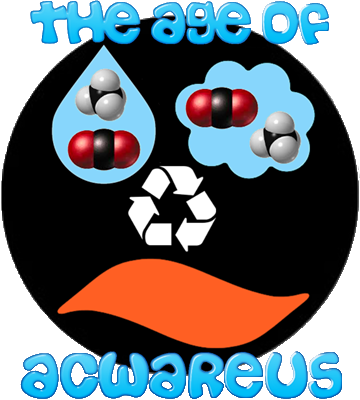
|
x o |
|
| > | ||
| o x |
| < |
Regardless of compound, Carbon (like in dioxide) is Energy Energy is not destructible, Energy is just transformable Make Use of Your Energy, Retransform Your Energy Don't Waste Your Energy, Recycle Your Waste Gases |
x o |
| > | ||
| o x |
| < |
Make fossil Waste Transmute into Clean Fuels Make fossil Waste a Renewable Energy Turn fossil Waste into a Present from the Past Turn fossil Waste into Friends for Ever to Last Save the Ocean and Lake Life from Dying. Make the World Secure against Drowning. As Walking in Circles means "Progress" Age of Reason long Past and far Gone As those ones we Trusted all Fail The Most Provident Camp Will Prevail Invest in or Sponsor  Today Today
"The greatest enemy of knowledge is not ignorance, it is the illusion of knowledge " — Stephen Hawking |
x o |
| > | ||
| o x |
| < |
@ <3 vill vi åstadkomma detta: 
1. Absorbera atmosfärisk & skorstens-emitterad CO2 (Carbon Capture) -> ... - Återanvända (Reuse) Kol-delen (CCR) JA ! - Lagra (Store/Sequester) CO2 (CCS) NEJ !! - Sänka temperaturer och därmed havsnivåer - Stabilisera, sedan sänka havs & sjöar försurning * - Försörja med ren, billig, riklig, hållbar energi 2. Absorbera atmosfärisk CH4, metan -> ... - Återanvända direkt som (L)NG, naturgas - Konvertera till andra kolväten 3. Rensa bort plastavfall från haven -> ... - Reparera näringskedjor & habitat ( * kombinerat med CCR-initiativ) - Rädda biologisk mångfald & populationer 4. Avsalta havsvatten (solenergi-driven) -> ... - Tillhandahålla dricksvatten i överflöd - Bevattna åkermark (mineralfritt liksom regn) - Stoppa & backa ökenutbredning 5. Partikelfilter på skorstenar, brännare, lastbilar, fartyg etc -> ... - Eliminera nedsmutsade glaciär- & polaris-ytor - (Ytors absorption av solljus snabbar på avsmältningen) - Avgifta bergsglacialt (floders) dricks- & bevattningsvatten - Förhindra jordskred och därigenom ge återskapa vegetationen |
x o |
| > | ||
| o x |
| < |
Our operational objectives: 
• sustainable energy - climate - economy solutions • atmospheric & aquatic compound balance restoration • climate regulation by recycling fossil fuel waste • energy regeneration from greenhouse gases • computer based molecular simulation & biomimetics • catalyst elaboration research software • atmospheric & aquatic carbonic waste reprocessing utilitarian software
We could never permanently remove atmospheric and
aquatic CO2 & other greenhouse gases -- We must balance their levels & reuse them, by recycling their intrinsic energy over and over again! " People think you're crazy if you talk about things they don't understand " — Elvis Presley |
x o |
| > | ||
| o x |
| < |
ACWAREUS CES is developing a unique software-based scientific tool for the development of molecules functioning as catalysts in applied artificial photosynthesis, which can be tailored to produce various hydrocarbon* fuels, out of high volume flows of atmospheric & aquatic greenhouse gases** at normal pressures and temperatures, as well as out of fumes or carbon-separated*** greenhouse gases from power plants & industry (CCR model). * Ethane and methane (natural gas), DME, butane, propane and heavier gases, methanol, ethanol and other alcohols, trimetypentan, hexadecane and various blends of gasoline, kerosene, diesel fuel, lubricating oil, etc., and other products such as ethylene & plastics, waxes, medicines, synthetic rubber, etc. ** CO2, CO, CH4 (methane), N2O ("laughing-gas"), H2O (water vapor), O3 (ozone), etc *** excepting subsequent deposition as in the CCS model " And those who were seen dancing were thought to be insane by those who could not hear the music " — Friedrich Nietzsche |
x o |
| > | ||
| o x |
| < |
Our software tool uses templates and science data to calculate the costs and outflows due to the inflow volume, the composition of the inflow gases, their pressure and temperature, and the selection of active catalyst. Our software also calibrates connected infrastructure (existing pipelines, ports, refineries, repositories, railways, highways and the expansion needs of those) and assesses geographically suitable locations based on available natural resources (sunshine, sea/lake water, possibly wind) and demographic, political, security and terrain-contingent considerations. " Many are those who profess, many are those who profiteer " — our own Renewables Industry assessment |
x o |
| > | ||
| o x |



NEW FUNCS & NEWSREEL 2017-08-06 » New section: Solutions & Product Concepts section. Feel enticed to get back to us with proposals, feedback and questions on this new section . Remember - Fantasy is tightly connected to Reality. Big Dreams always come true! 2016-11-27 » Acwareus new blog: Acwareus Wordpress Blog. Feel super welcome to post any comment, feedback or question in this new blog - our hope is that we shall build on this together. Say what You think - out loud! 2016-02-01 » Breaking news: Turning air into fuel: USC scientists convert carbon dioxide into methanol - super-efficiently and at lower temperatures. https://news.usc.edu/91297/turning-air-into-fuel-usc-scientists-turn-carbon-dioxide-into-methanol/ Today a report was issued from USC - University of Southern California - evidencing that atmospheric carbondioxide succesfully had been captured and recycled into methanol at temperatures between just 125 - 145 centigrades (Celsius scale). However slightly unfavorable their estimated full-scale facility production cost turned out in comparison with the currently minimal oil product prices, there is a clear trend pointing in the direction of more and more laboratories and scientists determinably and successfully endeavoring into the hunt for GHG (greenhouse gas) conversion into clean fuels. This implies that the time when new markets for those new products will emerge may be here sooner than expected. 
Our vision and our business aim is steadfast: we mean to help procure the world's energy producers with an arsenal of techniques to produce clean, cheap fuels at low costs, simultaneously turning what is slowly killing us all into profitable merchandise, instead miraculously beneficial to us all. Our CatELab-APS/e3 software will enable the elaboration of catalysts suitable for various conditions and applications: diluted atmospheric and seawater-dissolved GHGs at various temperatures and at normal atmospheric - aquatic pressures; aquatic GHGs dissolved in sea water; concentrated car exhaust outlet GHGs at high temperatures and elevated gas pressure (compare with today's nitrogen transforming catalytic converters, mandatory underneath every modern car); concentrated industry and power plant smokestack GHGs at reduced temperatures and moderate pressure; any today not anticipated application dealing with any range of concentration, temperature and pressure. Also, of course adapted to the type of fuel the energy producer desires to output at any given facility or mobile catalytic converter setup. This implies that we have designed our software to work with any given combined level of those four production conditions, be they high or low, dense or diluted, hot or cold, respectively. At the very finish line we wish to - and we see no reason not to - be able to offer a software that can be managed in a simple way by non-scientist personnel, simply operated through intuitive web browser interface parameter calibrations of the anticipated transformation process input conditions as well as the desired outputs by turn. 2015-10-09 » New utility: FleXray Anylyzer! - Flexible X-ray Analyzer - an omnifarious & omnipotent utility software for analyzing anything, any way. This utlility is integrated into the Important Facts & Docs section. Its functionality can be applied to any data of any type, coming from any source. This utility is developed by us as a stand-alone software package easily integrable onto any set of information source - documents, calculation sheets, videos, audios, photos, graphics, animations, databases, webplaces, maps ... whatever -- No "Big-Data"... c) : Works with any document format ... any video format ... any image format ... any raw data streaming in from anywhere, auto-structured by the reader function into crystal clear data and analyzed meeting your every need of clarity. So check it out and experience a new world of perceiving and dealing with... anything really... right at your fingertips, coming alive at your excited feet! This will turn you into a big-time juggler in total control - intuitively and with no effort. (the analyze functionality portion of this utility is available to FleXray subscribers and to CatELab licensees. Contact us for a demo and for additional information.) Stay tuned 4 addons! 2015-06-11 » New section: Important Facts & Docs section. Note: The transform image propoperties template (shown on mouse-over resize image icon for an opened image) currently does not work well with Mozilla Firefox browser. Stay tuned for coming support input! Feel encouraged to get back to us with feedback on this new section - that's how we can best improve concept and quality as we roll out new addon functionality. Think big & Never miss a thing! 2015-03-05 » New section: FAQs & answers! Will continually be extended so peek in regularly. Also feel very welcome to mail us questions, answers to FAQ'd questions, ideas, viewpoints, feedback, suggestions, proposals, complaints, and of course :) credits. We intend shortly to hang up a bulletin board in order to post notices not categorized as news nor graffiti, but with the same content as described above but back to you members & viewers -- answers to your questions etc, feedback on your ideas etc. Some questions of yours may also end up as new FAQ items. Be back soon! 2015-02-28 » New section: Graffiti Board! Boasting thoughts, ideas, postures, whatever! that You members or Ourselves want to "debrief" or delve into. N.b: all entries are anonymous and will be scrutinized before accepted. Commonplace ethics apply (racism, foul language, etc). Postings accepted will be aired within 24 hrs. Sorting by day or by category and day (decided shortly). There is a simple entry pane at bottom of the Board for you to enter your texts, maximum of 1000 characters. For non-anon postings, discussion threads, answers, etc, please utilize our Blog function. You may of course refer to Board entries in a Blog posting, but not conversely. Complaints category entries on the Board will be conveyed to a Complaints-anon ticket in the Blog. Get your spray cans out!! 2015-02-26 » New section: New Funcs & Newsreel! more items coming up soon ... |
x o |
|
| o x |






GRAFITTI BOARD - HEART & MIND Not exactly -- we at Acwareus don't really hang in casinos, 'cause to us those are mere temples of ignorance and unawareness, exploiting people's lust and irresponsibility :) "Do I feel lucky?" and "I f-k the future" are iconic lines of two epic movies, working well in their contexts, but neither in a casino (close that net plague down!) nor in the real world could those materialize the offspring of any responsible or logical thinking. Recycling atmospheric and aquatic waste gases is heretical to present-day mobs going "All Hydrocarbon is a no-no because it is consanguine or to us anyways congenial with its fossil fuel equivalents". We say: "Yes! That kinship is exactly what justifies and necessitates its implementation !!!!!" -- how else would you deal with all that atmospheric & aquatic waste? Dig it down in the ground? Capture it with a mouse trap'n'cheeze?? Think again and, if still no blue indicator lights up your face, again... The bloody age of inquisition is back, the clergy now being social retards and all-mouth politicians, unaware "journalists", and pathetic, ignorant indolents. Feeling lucky, that eeeeverything will turn out for the best (expressed thru politicians and other mindless mobs), or f-king the future (explicitly thru sociopaths and implicitly thru denialists) are spineless postures found inside far too many minds in our day. Interviewees are split about anything you might want to ask, on answering yes-and-no type of questions. The "No" side can thus always point to the fact that "the people" stand disunited before any environmental issue whatsoever. Ignore those inquiries, moreover often ordered by the "No" side representatives (and results may even be fake). Stop digesting (dis)information - Just Think for Yourself! Go from dissociated to associated, take a proactive approach to those issues and to solving them. Join community initiatives gradually gaining mass and momentum inducing demand for SEREPs (Socially & Environmentally Responsible Energy Productions). The only way that new markets for regenerated energy out of recycled waste gases can emerge !! Showcase big scale prototypes of CatELab-APS/e3 plants evidencing their promised positive environmental and economical effects. ~ ~ ~ ~ ~ ~ ~ ~ ~ ~ ~ ~ ~ ~ ~ ~ ~ ~ ~ ~ ~ ~ ~ ~ ~ ~ ~ ~ ~ ~ ~ ~ ~ ~ ~ ~ ~ ~ ~ ~ 2 word pairs are interconnected: Wait & See and Wave & Sea -- the more we indulge in the the first one, the more we'll expect of the second one. Like in: "The longer we Wait and See, the higher the Waves and Sea" Or interconnected like in: "Think I'll Wait & Sea" (Wait for the Sea :) And in wordplays, pairing literal meanings along with figurative ones, like: "Just tread water now - and soon enough you'll be doing just that in your hometown streets." "Just keep treading water - and you'll keep doing just that till the end of your days." ~ ~ ~ ~ ~ ~ ~ ~ ~ ~ ~ ~ ~ ~ ~ ~ ~ ~ ~ ~ ~ ~ ~ ~ ~ ~ ~ ~ ~ ~ ~ ~ ~ ~ ~ ~ ~ ~ ~ ~ A clean sky being our aim, not even the sky is a limit - remember that there are footprints on the moon. There are 3 roads to success: 1. Inhibition, 2. Adapting in bad ways, 3. Adapting smartly. Examples: 1. Immediately throttle all fossil fuel production & consumption. - Feasibility: non-existent. 2. Politicians' and populist companies' favorite:) raise protective barrages, build wind power forests. - Feasibility: practicably (however idiotic, nevertheless probably) guaranteed. 3. Regenerate energy from atmospheric, aquatic and smokestack waste slowly killing our planet. - Feasibility: depends on demand induced for clean, cheap products eliminating the planet killers. At Acwareus, we don't think outside the box - to Us there is None. We can see around corners - and We cut every One. Talk is cheap - let's just take what We have & get it Done. ACWAREUS CES Deliver Solutions - Not Excuses Join our TEAM - Together Everyone Accomplishes More ~ ~ ~ ~ ~ ~ ~ ~ ~ ~ ~ ~ ~ ~ ~ ~ ~ ~ ~ ~ ~ ~ ~ ~ ~ ~ ~ ~ ~ ~ ~ ~ ~ ~ ~ ~ ~ ~ ~ ~ “Here’s to the crazy ones. The misfits. The rebels. The troublemakers. The round pegs in the square holes. The ones who see things differently. They’re not fond of rules. And they have no respect for the status quo. You can quote them, disagree with them, glorify or vilify them. About the only thing you can’t do is ignore them. Because they change things. They invent. They imagine. They heal. They explore. They create. They inspire. They push the human race forward. Maybe they have to be crazy. How else can you stare at an empty canvas and see a work of art? Or sit in silence and hear a song that’s never been written? Or gaze at a red planet and see a laboratory on wheels? We make tools for these kinds of people. While some see them as the crazy ones, we see genius. Because the people who are crazy enough to think they can change the world, are the ones who do.” - Steve Jobs' foreword to a book of the Apple “Think Different” campaign in 1997-98 “Come writers and critics Who prophesize with your pen And keep your eyes wide The chance won't come again And don't speak too soon For the wheel's still in spin And there's no tellin' who That it's namin'. For the loser now Will be later to win For the times they are a-changin'.” - Bob Dylan/ The times they are a-changing ~ ~ ~ ~ ~ ~ ~ ~ ~ ~ ~ ~ ~ ~ ~ ~ ~ ~ ~ ~ ~ ~ ~ ~ ~ ~ ~ ~ ~ ~ ~ ~ ~ ~ ~ ~ ~ ~ ~ ~ “The most difficult thing is the decision to act, the rest is merely tenacity.” – Amelia Earhart “Experience teaches only the teachable” - Aldous Huxley “Your time is limited, so don’t waste it living someone else’s life.” – Steve Jobs “People with passion CAN change the world” - Steve Jobs An SBD device is a “Supreme Bullshit Detector” “I grew up thinking that it was normal to see things before they happen. Grown up, I learned that we call it scenarios.” DREAM. DESIGN. DEVELOP. DELIVER. “What was cannot be again, and what should have been will never come” “These who criticize you directly for your faults are your friends, not those who appear nice even when you’re wrong” “WE REMEMBER 10% of what we read 20% of what we hear 30% of what we see 50% of what we see and hear 70% of what we discuss with others 80% of what we personally experience 95% of what we teach others” - Edgar Dale “Everything is doomed to destruction” - Herodotos “In our time, ambition is darkened by greed and indolence” - Kenneth Clark “We can't learn anything from history except that everything leads to unintentional consequences” - Tom Holland “During times of universal deceit, telling the truth becomes a revolutionary act” - George Orwell “If you're confused about what to do, it's a sign that your enemy is winning” ― Toba Beta “Do I not destroy my enemies when I make them my friends?” ― Abraham Lincoln “Not all who wander are lost” - J. R. R. Tolkien “It is amazing what you can accomplish if you don't care who gets the credit” - Harry S Truman “Logic will take you from A to B. Imagination takes you everywhere” - Albert Einstein “We cannot solve our problems with the same thinking we used when we created them” - Albert Einstein “Imagination is more important than knowledge” - Albert Einstein. “Every person that you meet knows something you don't; learn from them” - H. Jackson Brown Jr. “If opportunity doesn't knock, build a door then” - Milton Berle “I cannot do all the good that the world needs, but the world needs all the good that I can do” - Jana Stansfield “It is impossible to live without failing at something, unless you live so cautiously that you might as well not have lived at all, in which case you have failed by default” – J.K. Rowling “There are no eternal facts, as there are no absolute truths” - Friedrich Nietzsche “if you wish to strive for peace of soul and pleasure, then believe; if you wish to be a devotee of truth, then inquire” - Friedrich Nietzsche “I am always doing that which I can not do - in order to learn how to do it” - Pablo Picasso “Every time I thought I was being rejected from something good, I was actually being re-directed to something better” - Steve Maraboli Trying to mitigate climate change effects by adapting to them is like trying to cure obesity by loosening your belt. (“Trying to cure traffic congestion by adding capacity is like...” - Glen Hiemstra) If everything seems under control you are not going fast enough Explore your imagination, the possibilities are infinite Disruption can be predicted but few have the guts to act Regardless of size and success, no one is safe Success is more attitude than aptitude End user appeal beats everything Doers get what they want. Everyone else get what they get The price of anything is the amount of life you exchange for it A dream we dream alone is a only a dream, a dream we dream together is reality The best way to predict the future is to create it Let History Begin Not because it's easy, but because it's necessary (“...but because it's hard”, Jonh F Kennedy said on planning moon voyages in 1962) In the 20th Century, we had ideologies. In the 21st Century, we have DATA. Most of the problems we face today are simply a hangover from the 20th Century where ideologies dominated. Now we have empirics. We must push past the noise of those who still shout about why their ideology is better than someone else's. We must use data to collaborate, create and innovate Directions for the next road comes from all the ones prior traveled The distance between your dreams and reality is called ACTION! |
x o |
|
| o x |



SOUNDING BOARD - FEEDBACKS This section will be featuring you members' and our own questions, answers to those, ideas, viewpoints, feedback, suggestions, proposals, complaints, and of course :) credits - non categorized as news nor graffiti, but bouncing back to you members & viewers -- members' & viewers'answers and ours to your questions etc, feedback on your ideas etc. Some questions of yours may also qualify as new FAQ items and end up in that section, some entries may categorize as graffiti and be conveyed to that section. coming soon! |
x o |
|
| o x |


FAQs & ANSWERS
Here are all posts in our WordPress Blog:
Here's our Shop/Publications/Donations page & upcoming Crowd Funding Campaign: Our page for Shopping, Publications, Donations - Deals etc. Our upcoming funding campaign (yet a "semi-draft") 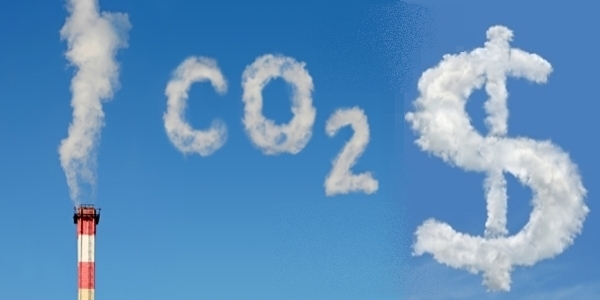 more coming up soon ... |
x o |
||||||||||||||||||||||||||||||||||||||||||||||||||||||||||||||||||||||||||||||||||||||||||||||||||||||||||||||
| o x |
|||||||||||||||||||||||||||||||||||||||||||||||||||||||||||||||||||||||||||||||||||||||||||||||||||||||||||||||

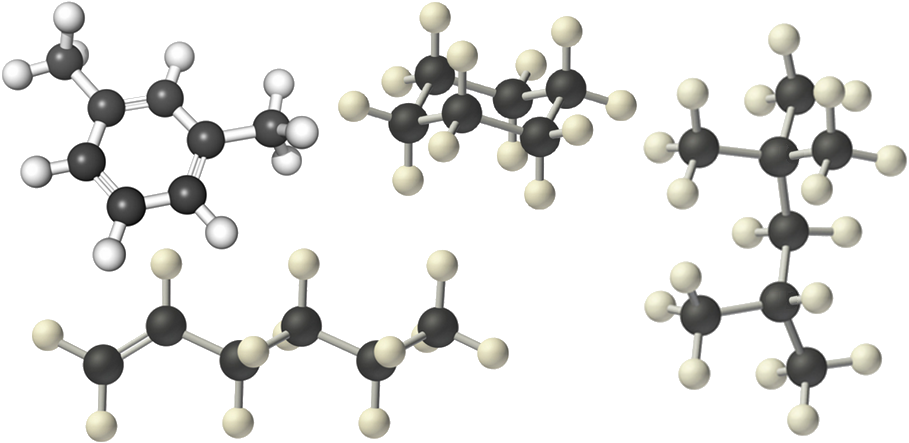




 IMPORTANT FACTS & DOCS
IMPORTANT FACTS & DOCS

This section will be featuring a selection of facts that we've dug out and that You'll dig out all by Yourself. Cause it's fun and easy! You may comment on each document and supply links to your own documents - your private ones and those you wish to see public (upon our scrutiny). We'll boast a menu of available facts and documents enabling juggling those ones you've already opened. Our advanced cross-document, cross-web, cross-science database FleXray Anylyzer (re)search & analysis utility is herein integrated, enabling you to lay the most elaborate jigsaw-puzzles instantly all by yourself. Stay tuned! You'll find entirely new ways of dealing with facts, resulting in an "Einsten - Holmes" crossover capability eliminating that tedious and confusing computer work we've been fed for all to long. To hell with the old school canteen, say hello to a dining mall to your exclusive likings! Topics, among thousands upon thousands relevant ones out there, comprise e.g: • artificial photosynthesis • scenarios & consequences • major world cities • greenhouse gas sources • climate & energy • demography & population at risk • flooding maps (in new tab): flood.firetree.net & geology.com/sea-level-rise Information sources are uncountable & tough to juggle. Except right in here - So go find it all out 4 Yourself !!' more coming soon! |
x o |
|
| o x |
|
IMAGE GALLERY coming soon!
|
x o |
|||
| o x |
| < |
SOLUTIONS & PRODUCT CONCEPTS  Atmospheric and Aquatic GreenHouse Gases (GHGs) constitute a clean, cheap energy resource for as long as we like them to.
Atmospheric and Aquatic GreenHouse Gases (GHGs) constitute a clean, cheap energy resource for as long as we like them to.Converting them by cyclic CCR (APS)* techniques render us eternal energy, a replacement for fossil fuels. *APS=Applied Artificial PhotoSynthetic Catalytic Processes (thousandfold more efficient than natural photosynthesis in plants) *CCR=Carbon (dioxide) Capture and Recycle (instead of Store/Sequester as with CCS)  Big Oil have no Climate Action plan, just their Business As Usual plan Turning air into fuel. Turning Greenhouse Gases into new energy. Turning bad waste into things of good. Super-efficiently and at low costs. Those events would undoubtedly imply a dream come true to every entrepreneurial minded scientist as well as energy producer. There is a clear trend pointing in the direction of more and more laboratories and scientists determinably and successfully endeavoring into the hunt for GHG conversion into clean fuels. This implies that the time when new markets for those new products will emerge may be here sooner than expected. Our vision and our business aim is steadfast: we mean to help procure the world's energy producers with an arsenal of techniques to produce clean, cheap fuels at low costs, simultaneously turning what is slowly killing us all into profitable merchandise, instead miraculously beneficial to us all.  Fossil Emissions 0 in our Monocular - from Enairgy Magic? No, Simple Logic! Our CatELab-APS/e3 software will enable the elaboration of catalysts suitable for various conditions and applications: 》 》 diluted atmospheric and seawater-dissolved GHGs at various temperatures and at normal atmospheric - aquatic pressures » view more 》 concentrated car exhaust outlet GHGs at high temperatures and elevated gas pressure (compare with today's NO2 + CO + HC* transforming catalytic converters, in many countries mandatory underneath every modern car) » view more 》 concentrated industry and power plant smokestack GHGs at reduced temperatures and moderate pressure » view more 》 any today not anticipated application dealing with any range of concentration, temperature and pressure 》 Also of course, adapted to the type of fuel the energy producer desires to output at any given facility or mobile catalytic converter setup This implies that we have designed our software to work with any given combined level of those four or five production conditions, be they high or low, dense or diluted, hot or cold, respectively. At the end of the day we aim to offer a software that can be managed in a simple way by non-scientist personnel, simply operated through intuitive web browser interface parameter calibrations of the anticipated transformation process input conditions as well as the desired outputs by turn.  Not improbable to us at ACES, our software may go down in history as The Major Turning Point in turning our energy production paradigm over —
Not improbable to us at ACES, our software may go down in history as The Major Turning Point in turning our energy production paradigm over — from the old one based on a disgraceful, fossil-fuels centered Big Oil Friendly Agenda — into the new one based on a climate remedial, net minus emissions centered, Renewable Fuels- & Planetary Resilience- Friendly Agenda. That Turning Point is second in line to this 1: ➽ FUNDING
|
x o > |
||
| < | > | |||
| < |
> o x |
| < |
SCIENCE & TECHNOLOGY BASES 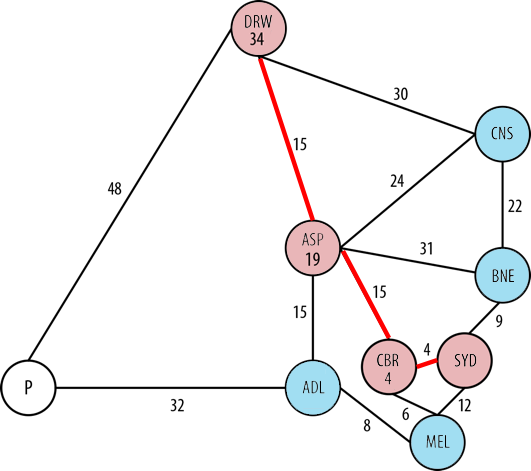 Technologic & scientific databases & datasheets — — maths — algorithms — patterns — structures — sets — templates — num/prox methods — AI — — etc, all input feeding the kernel & integrated E-lab to our CatELab-APS/e3 catalytic processes simulation engineering software
Technologic & scientific databases & datasheets — — maths — algorithms — patterns — structures — sets — templates — num/prox methods — AI — — etc, all input feeding the kernel & integrated E-lab to our CatELab-APS/e3 catalytic processes simulation engineering softwareMajor Science Databases — Key Databases, samples 》 — examples of essential online science and math resources utilized — definitions predominantly conforming to arXiv.org standards 》 Mathematics 》 Statistics 》 Physics 》 Chemistry 》 Biology 》 BioChemistry 》 Bionics - Bioneering 》 Biomimetics/ Biomimicry 》 Nanotechnology 》 Environmental Science 》 Computer Science 》 Numerical Simulation 》 Nonlinear Science 》 Condensed Matter 》 Electricity 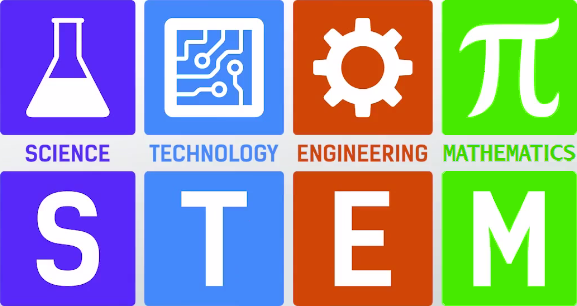
Relevant samples of related images in snatches of scientific objects dealt with in process analyzes 》 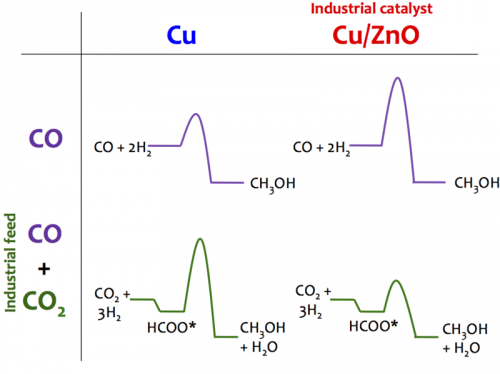 》 Hydrogenation to Methanol over Cu/Zn-Based Catalysts. CO and CO2, on copper, can be hydrogenated to methanol, but not at the same time. The former reaction is poisoned by CO2 and requires a carbophilic Cu step, whereas the latter reaction requires a Zn promoter and proceeds as an oxophilic Cu/Zn step. 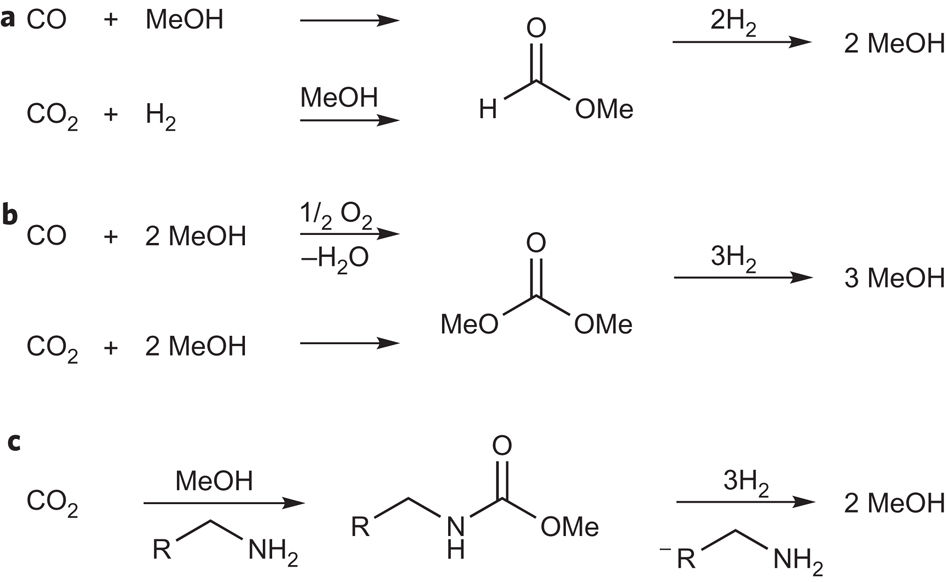 》 Alternate routes to production of methanol based fuels. More recently, methanol has been considered as an alternative fuel. A new process is hydrogenation of CO2 for methanol production. The dominating production method of methanol synthesis is through the synthesis gas process first developed during the 1920s. A gas mixture of hydrogen and carbon monoxide (usually also carbon dioxide), known as synthesis gas (syngas) is the basis for almost all methanol production today. An attractive alternative is enzymatic conversion, although most research in this area is currently focused on ethanol production. While biomass and other waste materials is a possible and probable route to gradually decrease our dependence on fossil energy sources there are technologies available that allows us to produce methanol and at the same time reduce the carbon dioxide emissions into our atmosphere & oceans. The process consists of combining hydrogen and carbon dioxide to produce methanol with the only by-product being oxygen from the elect. The instance when suffiently low production costs allow for attractive consumer products, existing as well as new markets are most likely to surge explosively, leaving Big Fossil once and for all helplessly behind. 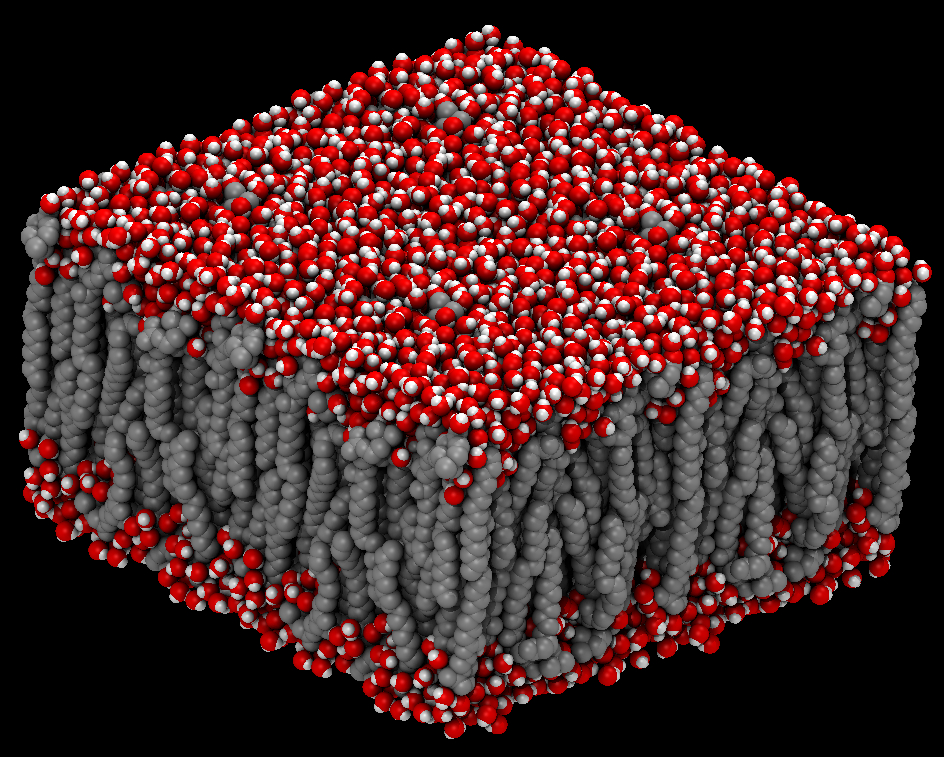 》 POPC lipid membrane and water molecules covering the surfaces of two lipid leaflets — 3D data rendering by VMD modeling software POPC is a phosphatidylcholine. It is a diacylglycerol and phospholipid. The full name is 1-palmitoyl-2-oleoyl-sn-glycero-3-phosphocholine. It is an important phospholipid for biophysical experiments and has been used to study various subjects such as lipid rafts. POPC also used in systems mimicking the cell membrane such as Nanodiscs.[1] It is available commercially synthetically[2] and is naturally present in eukaryotic cell membranes. more coming soon!
|
x o > |
||
| < | > | |||
| < |
> o x |
| < |
CCR (CARBON CAPTURE & RECYCLE) TECHNOLOGIES Carbon Recycling CCR outclassing Carbon Capture & Storage CCS 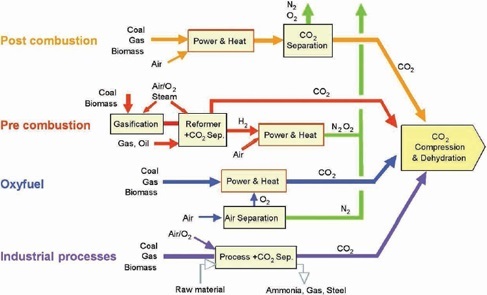 CO2 capture can be carried out through four main processes: post-combustion, pre-combustion, oxy-combustion and industrial processes separation. Diverting compressed CO2 for subsequent Storage (a.k.a. "Sequestration") as with CCS implies a Pyramidal Waste of Energy, intrinsic in the Carbon portion of CO2, CO, and CH4... and hence of course also a Pyramidal Waste of Money!  Options for retracting the Carbon (i.e. Energy) portion of the captured CO2 and recombining it with Hydrogen into hydrocarbons, alternatively with additional oxygen into alcohols, today being developed globally include »
Options for retracting the Carbon (i.e. Energy) portion of the captured CO2 and recombining it with Hydrogen into hydrocarbons, alternatively with additional oxygen into alcohols, today being developed globally include »» the biochemical conversion of CO2 into algal biofuel, » the thermochemical conversion into methanol, and » the biocatalytic or solar photocatalytic conversion of CO2 to fuels. This has been going on for quite some time, a decade or more in each case. But no CCR products have found their way out on markets as yet. Or things get in the way... like uncompetitive production costs... entailing unattractive retailer prices. Our applied model of Reutilizing the GHG intrinsic Carbon Energy ensuing the Capture operation step, in those four main processes, schematically comes out accordingly: 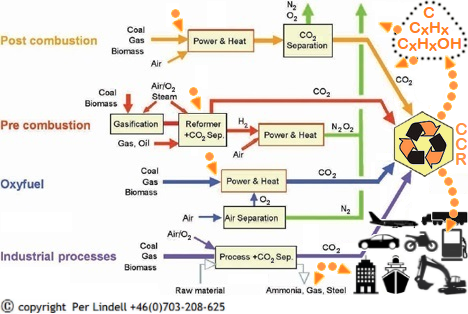 The CO2 capture and separation steps are most wisely ensued by CCR (R for Recycle and Reutilization) steps... "Don't Waste Your Energy!". CO2 capture ensued by reutilization of the Carbon portion through Hydrogen and (any) Oxygen recombination in CCR processes into new fuels (dotted orange parts) — synthetic, therefore fossil-outcompeting — liquid (gasoline/petrol/kerosene etc) or gaseous (methane/buthane/propane etc) or solid (coal/utilities) HYDROCARBONS, ALCOHOLS (ethanol/methanol), and tars, waxes, plastics commodity (ethylene etc). "Well, talk is cheap", I've overheard some people utter or mutter, most likely ignorant of the tasks and challenges involved herein. Because, in order to induce new markets out of new products, they have have to come at competitive pricing — market economies simply work that way. And here lay the difficulties: low production prices is the trick of the tail, and in this sense, this noble art is a one-trick pony.
 CCS ...  Carbon capture and storage (CCS) is being hailed as the answer to the globe's most pressing question: what to do with the 43 billion metric tons of carbon dioxide emitted yearly from the burning of fossil fuels? Touted as the most promising interim solution to deal with the greenhouse gas responsible for global warming, CCS still remains unproven, costly and will not be commercially available for another 10-20 years. Meanwhile scientists are exploring alternatives to CCS by capitalizing on CO2 as a commodity instead of treating it as a waste. 43 billion tons of CO2 is already a hefty number but energy-related carbon dioxide emissions are projected to reach 58 billion metric tons per year by 2030, an increase of 35%. A new report by the International Energy Agency (IEA) estimates that growing energy demands from emerging giants like China and India, coupled with a lack of cost-effective alternatives to fossil fuels means that by 2050, 77% of the world's power will still be derived from fossil fuels. Carbon capture and storage (CCS), the process of capturing carbon dioxide and storing it in deep geological formations, in the deep ocean floor or as mineral carbonates, is being promoted by the IEA and others as the most promising technology to deal with fossil-fuel derived emissions. Not negating the role of alternative energies, the IEA is merely realistic about the enduring use of fossil fuels and the urgent need to deal with the resulting carbon dioxide. Nevertheless, several massive hurdles still stand in the way of full-scale CCS deployment. UK consulting firm McKinsey figures that adding CCS to the next generation of European power plants could lift their price by up to $1.3S billion each. Their thorough analysis (www.mckinsey.com) shows that the typical cost of a demonstration project is likely to be in the range of $80-$120 per ton of CO2 sequestered. Legally, there are concerns over whether CO2 transport and long-term storage present human or ecosystem related risks and who is ultimately responsible if a leak occurs. While progress is underway in some countries, no country has yet developed the comprehensive, detailed legal and regulatory framework that is necessary to effectively govern the use of CCS. So why expensively transport and store the CO2 underground when it could be profitably recycled post-capture? Researchers and start-up companies are now investigating a wide range of CO2 conversion methods. Some have published results — the closest to market incentives we can discern are CO2 transformation success into DME (DiMethylEther) and Methanol alcohol. But, and that's a BIG But, at predicted horrendous full-scale production costs — due to production requisites including i.a. high temperature and/or pressure implying high costs already in themselves but also in need for very robust, withstanding production equipment - pressure, heat, corrosion etc, dictating needs for e.g. equipment size, piping thickness, choice of materials etc.  CCR ...  Carbon Capture and Recycle (CCR) sometimes referred to as Carbon Capture and Utilize (CCU)
The following material is compiled chiefly from Wikipedia. A more complete, lucid, to-the-point and yet comparatively concise material is probably nowhere to be found. Impressive. Carbon-neutral fuels can refer to a variety of energy fuels or energy systems which have no net greenhouse gas emissions or carbon footprint. One class is synthetic fuel (including methane, gasoline, diesel fuel, jet fuel or ammonia[1]) produced from sustainable or nuclear energy used to hydrogenate waste carbon dioxide recycled from power plant flue exhaust gas or derived from carbonic acid in seawater. Other types can be produced from renewable energy sources such as wind turbines, solar panels, and hydroelectric power stations.[2][3][4][5] Such fuels are potentially carbon-neutral because they do not result in a net increase in atmospheric & aquatic greenhouse gases.[6][7] Until captured carbon is used for plastics feedstock, carbon neutral fuel synthesis is the primary means of carbon capture and utilization or recycling.[8] To the extent that carbon-neutral fuels displace fossil fuels, or if they are produced from waste carbon or seawater carbonic acid, and their combustion is subject to carbon capture at the flue or exhaust pipe, they result in negative carbon dioxide emission and net carbon dioxide removal from the atmosphere & from sea water, and thus constitute a form of greenhouse gas remediation.[9][10][11][12] Such power to gas carbon-neutral and carbon-negative fuels can be produced by the electrolysis of water to make hydrogen used in the Sabatier reaction to produce methane which may then be stored to be burned later in power plants as synthetic natural gas, transported by pipeline, truck, or tanker ship, or be used in gas to liquids processes such as the Fischer–Tropsch process to make traditional fuels for transportation or heating.[13][14][15] Carbon-neutral fuels are used in Germany and Iceland for distributed storage of renewable energy, minimizing problems of wind and solar intermittency, and enabling transmission of wind, water, and solar power through existing natural gas pipelines. Such renewable fuels could alleviate the costs and dependency issues of imported fossil fuels without requiring either electrification of the vehicle fleet or conversion to hydrogen or other fuels, enabling continued compatible and affordable vehicles.[13] A 250 kilowatt synthetic methane plant has been built in Germany and it is being scaled up to 10 megawatts.[16] ProductionCarbon-neutral fuels are synthetic hydrocarbons. They can be produced in chemical reactions between carbon dioxide, which can be captured from power plants, from the sea or the air, and hydrogen, which is created by the electrolysis of water using renewable energy. The fuel, often referred to as electrofuel, stores the energy that was used in the production of the hydrogen.[17] Coal can also be used to produce the hydrogen, but that would not be a carbon-neutral source. Carbon dioxide can be captured and buried, making fossil fuels carbon-neutral, although not renewable. Carbon capture from exhaust gas can make carbon-neutral fuels carbon negative. Other hydrocarbons can be broken down to produce hydrogen and carbon dioxide which could then be stored while the hydrogen is used for energy or fuel, which would also be carbon-neutral.[18] The most energy-efficient fuel to produce is hydrogen gas,[19] which can be used in hydrogen fuel cell vehicles, and which requires the fewest process steps to produce. Methanol can be made from a chemical reaction of a carbon-dioxide molecule with three hydrogen molecules to produce methanol and water. The stored energy can be recovered by burning the methanol in a combustion engine, releasing carbon dioxide, water, and heat. Methane can be produced in a similar reaction. Special precautions against methane leaks are important since methane is nearly 100 times as potent as CO2, in terms of Global warming potential.[citation needed] More energy can be used to combine methanol or methane into larger hydrocarbon fuel molecules.[13] Researchers have also suggested using methanol to produce dimethyl ether. This fuel could be used as a substitute for diesel fuel due to its ability to self ignite under high pressure and temperature. It is already being used in some areas for heating and energy generation. It is nontoxic, but must be stored under pressure.[20] Larger hydrocarbons[19] and ethanol[21] can also be produced from carbon dioxide and hydrogen. All synthetic hydrocarbons are generally produced at temperatures of 200–300 °C, and at pressures of 20 to 50 bar. Catalysts are usually used to improve the efficiency of the reaction and create the desired type of hydrocarbon fuel. Such reactions are exothermic and use about 3 mol of hydrogen per mole of carbon dioxide involved. They also produce large amounts of water as a byproduct.[2] Sources of carbon for recyclingThe most economical source of carbon for recycling into fuel is flue-gas emissions from fossil-fuel combustion where it can be obtained for about USD $7.50 per ton.[4][7][14] Automobile exhaust gas capture has also been seen as economical but would require extensive design changes or retrofitting.[22] Since carbonic acid in seawater is in chemical equilibrium with atmospheric carbon dioxide, extraction of carbon from seawater has been studied.[23][24] Researchers have estimated that carbon extraction from seawater would cost about $50 per ton.[5] Carbon capture from ambient air is more costly, at between $600 and $1000 per ton and is considered impractical for fuel synthesis or carbon sequestration.[7][9] Direct air capture is less developed than other methods. Proposals for this method involve using a caustic chemical to react with carbon dioxide in the air to produce carbonates. These can then be broken down and hydrated to release pure CO2 gas and regenerate the caustic chemical. This process requires more energy than other methods because carbon dioxide is at much lower concentrations in the atmosphere than in other sources.[13] Researchers have also suggested using biomass as a carbon source for fuel production. Adding hydrogen to the biomass would reduce its carbon to produce fuel. This method has the advantage of using plant matter to cheaply capture carbon dioxide. The plants also add some chemical energy to the fuel from biological molecules. This may be a more efficient use of biomass than conventional biofuel because it uses most of the carbon and chemical energy from the biomass instead of releasing as much energy and carbon. Its main disadvantage is, as with conventional ethanol production, it competes with food production.[2]
Renewable and nuclear energy costsNighttime wind power is considered the most economical form of electrical power with which to synthesize fuel, because the load curve for electricity peaks sharply during the warmest hours of the day, but wind tends to blow slightly more at night than during the day. Therefore, the price of nighttime wind power is often much less expensive than any alternative. Off-peak wind power prices in high wind penetration areas of the U.S. averaged 1.64 cents per kilowatt-hour in 2009, but only 0.71 cents/kWh during the least expensive six hours of the day.[13] Typically, wholesale electricity costs 2 to 5 cents/kWh during the day.[25] Commercial fuel synthesis companies suggest they can produce gasoline for less than petroleum fuels when oil costs more than $55 per barrel.[26] The U.S. Navy estimates that 100 megawatts of electricity can produce 41,000 gallons of jet fuel per day and shipboard production from nuclear power would cost about $6 per gallon. While that was about twice the petroleum fuel cost in 2010, it is expected to be much less than the market price in less than five years if recent trends continue. Moreover, since the delivery of fuel to a carrier battle group costs about $8 per gallon, shipboard production is already much less expensive.[27] Demonstration projects and commercial developmentA 250 kilowatt methane synthesis plant was constructed by the Center for Solar Energy and Hydrogen Research (ZSW) at Baden-Württemberg and the Fraunhofer Society in Germany and began operating in 2010. It is being upgraded to 10 megawatts, scheduled for completion in autumn, 2012.[28][29] The George Olah carbon dioxide recycling plant operated by Carbon Recycling International in Grindavík, Iceland has been producing 2 million liters of methanol transportation fuel per year from flue exhaust of the Svartsengi Power Station since 2011.[30] It has the capacity to produce 5 million liters per year.[31] Audi has constructed a carbon-neutral liquefied natural gas (LNG) plant in Werlte, Germany.[32] The plant is intended to produce transportation fuel to offset LNG used in their A3 Sportback g-tron automobiles, and can keep 2,800 metric tons of CO2 out of the environment per year at its initial capacity.[33] Commercial developments are taking place in Columbia, South Carolina,[34] Camarillo, California,[35] and Darlington, England.[36] A demonstration project in Berkeley, California proposes synthesizing both fuels and food oils from recovered flue gases.[37] Greenhouse gas remediationCarbon-neutral fuels might lead to greenhouse gas remediation because carbon dioxide gas would be reused to produce fuel instead of being released into the atmosphere. Capturing the carbon dioxide in flue gas emissions from power plants would eliminate their greenhouse gas emissions, although burning the fuel in vehicles would release that carbon because there is no economical way to capture those emissions.[13] This approach would reduce net carbon dioxide emission by about 50% if it were used on all fossil fuel power plants. Most coal and natural gas power plants have been predicted to be economically retrofittable with carbon dioxide scrubbers for carbon capture to recycle flue exhaust or for carbon sequestration.[38][7][10] Such recycling is expected to not only cost less than the excess economic impacts of climate change if it were not done, but also to pay for itself as global fuel demand growth and peak oil shortages increase the price of petroleum and fungible natural gas.[9][11] Capturing CO2 directly from the air or extracting carbonic acid from seawater would also reduce the amount of carbon dioxide in the environment, and create a closed cycle of carbon to eliminate new carbon dioxide emissions.[2] Use of these methods would eliminate the need for fossil fuels entirely, assuming that enough renewable energy could be generated to produce the fuel. Using synthetic hydrocarbons to produce synthetic materials such as plastics could result in permanent sequestration of carbon from the atmosphere.[13] Traditional fuels, methanol or ethanolSome authorities have recommended producing methanol instead of traditional transportation fuels. It is a liquid at normal temperatures and can be toxic if ingested. Methanol has a higher octane rating than gasoline but a lower energy density, and can be mixed with other fuels or used on its own. It may also be used in the production of more complex hydrocarbons and polymers. Direct methanol fuel cells have been developed by Caltech's Jet Propulsion Laboratory to convert methanol and oxygen into electricity.[20] It is possible to convert methanol into gasoline, jet fuel or other hydrocarbons, but that requires additional energy and more complex production facilities.[13] Methanol is slightly more corrosive than traditional fuels, requiring automobile modifications on the order of USD $100 each to use it.[2][39] In 2016, a method using carbon spikes, copper nanoparticles and nitrogen that converts carbon dioxide to ethanol was developed.[40] HistoryInvestigation of carbon-neutral fuels has been ongoing for decades. A 1965 report suggested synthesizing methanol from carbon dioxide in air using nuclear power for a mobile fuel depot.[41] Shipboard production of synthetic fuel using nuclear power was studied in 1977 and 1995.[42][43] A 1984 report studied the recovery of carbon dioxide from fossil fuel plants.[44] A 1995 report compared converting vehicle fleets for the use of carbon-neutral methanol with the further synthesis of gasoline.[39] See alsoReferences  [show] [show]
Further reading
External links

|
x o > |
||||||||||||||||||||||||
| < | > | |||||||||||||||||||||||||
| < |
> o x |
| < |

CATALYST ELABORATION & SIMULATION LAB SETS 
|
x o > |
||||||||||||||||||||||||||
| < | > | |||||||||||||||||||||||||||
| < |
> o x |
|||||||||||||||||||||||||||
| < |
ATMOSPHERIC & AQUATIC WASTE ENERGY RECOVERY 
This is the conceptual principle outline for the APS atmospheric & aquatic energy retraction concept — put simply, the magic that goes on inside of it, visualizing the wonders of catalytically aided chemical, biological, biochemical and other [combined] processes: -outline-VECTORIZED-567x396-COPYRIGHT-PER-LINDELL-DO-NOT-COPY.png) Simple is beautiful, as with all sustainable notions. In order to separate greenhouse gases like Carbondioxide CO2, we need an adsorbent. The following material is compiled chiefly from Wikipedia. An impressive exposure of scientific facts on the subject. Where we deem enhancing or emphasizing certain sections of it, we have completed (in line with Wikipedia terms of usage) it with material of our own or of other origin. Searching Wikipedia for "Solid sorbents for carbon capture" (or any subset or alternative thereof) will i.a. render the below portrayal of Carbon capture sorbents — albeit, as said, modified at places. Enjoy! An adsorbent is an insoluble material coated by liquid on the surface, including capillaries and pores. A material is said to be adsorbent when it has the capacity to contain a definite amount of liquid in small chambers similar to a sponge. Adsorbents play a vital role in chemical absorption, which takes place when a certain substance is trapped on a material's surface. Adsorption is the process of a liquid or gas accumulating on a liquid or solid surface, building an atomic or molecular film. It is substantially different from the process of absorption, where a substance goes through diffusion into a solid or liquid to produce a solution. Solid sorbents for carbon capture include a diverse range of porous, solid-phase materials, including mesoporous silicas, zeolites and metal-organic frameworks. These have the potential to function as more efficient alternatives to amine gas treating processes for selectively removing CO2 from large, stationary sources including power stations.[1] While the technology readiness level of solid adsorbents for carbon capture varies between the research and demonstration levels, solid adsorbents have been demonstrated to be commercially viable for life-support and cryogenic distillation applications. While solid adsorbents suitable for carbon capture and storage are an active area of research within materials science, significant technological and policy obstacles limit the availability of such technologies. ContentsOverviewThe combustion of fossil fuels generates over 13 gigatons of CO2 per year.[2] Concern over the effects of CO2 with respect to climate change and ocean acidification led governments and industries to investigate the feasibility of technologies that capture the resultant CO2 from entering the carbon cycle. For new power plants, technologies such as pre-combustion and oxy-fuel combustion may simplify the gas separation process. However, existing power plants require the post-combustion separation of CO2 from the flue gas with a scrubber. In such a system, fossil fuels are combusted with air and CO2 is selectively removed from a gas mixture also containing N2, H2O, O2 and trace sulphur, nitrogen and metal impurities. While exact separation conditions are fuel and technology dependent, in general CO2 is present at low concentrations (4-15% v/v) in gas mixtures near atmospheric pressure and at temperatures of approximately 40-60 °C.[3] Sorbents for carbon capture are regenerated using temperature, pressure or vacuum, so that CO2 can be collected for sequestration or utilization and the sorbent can be reused. The most significant impediment to carbon capture is the large amount of electricity required.[4] Without policy or tax incentives, the production of electricity from such plants is not competitive with other energy sources.[5] The largest operating cost for power plants with carbon capture is the reduction in the amount of electricity produced,[6] because energy in the form of steam is diverted from making electricity in the turbines to regenerating the sorbent. Thus, minimizing the amount of energy required for sorbent regeneration is the primary goal behind much carbon capture research. MetricsSignificant uncertainty exists around the total cost of post-combustion CO2 capture because full-scale demonstrations of the technology have yet to come online.[7] Thus, individual performance metrics are generally relied upon when comparisons are made between different adsorbents.[8] Regeneration energy—Generally expressed in energy consumed per weight of CO2 captured (e.g. 3,000 kJ/kg). These values, if calculated directly from the latent and sensible heat components of regeneration, measure the total amount of energy required for regeneration.[9] Parasitic energy—Similar to regeneration energy, but measures how much usable energy is lost. Owing to the imperfect thermal efficiency of power plants, not all of the heat required to regenerate the sorbent would actually have produced electricity.[10] Adsorption capacity—The amount of CO2 adsorbed onto the material under the relevant adsorption conditions. Working capacity—The amount of CO2 that can be expected to be captured by a specified amount of adsorbent during one adsorption–desorption cycle. This value is generally more relevant than the total adsorption capacity. Selectivity—The calculated ability of an adsorbent to preferentially adsorb one gas over another gas. Multiple methods of reporting selectivity have been reported and in general values from one method are not comparable to values from another method. Similarly, values are highly correlated to temperature and pressure.[11] Comparison to aqueous amine absorbentsAqueous amine solutions absorb CO2 via the reversible formation of ammonium carbamate, ammonium carbonate and ammonium bicarbonate.[12] The formation of these species and their relative concentration in solution is dependent upon the specific amine or amines as well as the temperature and pressure of the gas mixture. At low temperatures, CO2 is preferentially absorbed by the amines and at high temperatures CO2 is desorbed. While liquid amine solutions have been used industrially to remove acid gases for nearly a century, amine scrubber technology is still under development at the scale required for carbon capture.[13] AdvantagesMultiple advantages of solid sorbents have been reported. Unlike amines, solid sorbents can selectively adsorb CO2 without the formation of chemical bonds (physisorption). The significantly lower heat of adsorption for solids requires less energy for the CO2 to desorb from the material surface. Also, two primary or secondary amine molecules are generally required to absorb a single CO2 molecule in liquids. For solid surfaces, large capacities of CO2 can be adsorbed. For temperature swing adsorption processes, the lower heat capacity of solids has been reported to reduce the sensible energy required for sorbent regeneration.[8] Many environmental concerns over liquid amines can be eliminated by the use of solid adsorbents.[5] DisadvantagesManufacturing costs are expected to be significantly greater than the cost of simple amines. Because flue gas contains trace impurities that degrade sorbents, solid sorbents may prove to be prohibitively expensive. Significant engineering challenges must be overcome. Sensible energy required for sorbent regeneration cannot be effectively recovered if solids are used, offsetting their significant heat capacity savings. Additionally, heat transfer through a solid bed is slow and inefficient, making it difficult and expensive to cool the sorbent during adsorption and heat it during desorption. Lastly, many promising solid adsorbents have been measured only under ideal conditions, which ignores the potentially significant effects H2O can have on working capacity and regeneration energy. Physical adsorbentsCarbon dioxide adsorbs in appreciable quantities onto many porous materials through van der Waals interactions. Compared to N2, CO2 adsorbs more strongly because the molecule is more polarizabable and possesses a larger quadrupole moment.[8] However, stronger adsorptives including H2O often interfere with the physical adsorption mechanism. Thus, discovering porous materials that can selectively bind CO2 under flue gas conditions using only a physical adsorption mechanism is an active research area. ZeolitesZeolites, a class of porous aluminosilicate solids, are currently used in a wide variety of industrial and commercial applications including CO2 separation. The capacities and selectivities of many zeolites are among the highest for adsorbents that rely upon physisorption. For example, zeolite Ca-A (5A) has been reported to display both a high capacity and selectivity for CO2 over N2 under conditions relevant for carbon capture from coal flue gas, although it has not been tested in the presence of H2O.[14] Industrially, CO2 and H2O can be co-adsorbed on a zeolite, but high temperatures and a dry gas stream are required to regenerate the sorbent.[10] Metal-organic frameworksMetal-organic frameworks (MOFs) are promising adsorbents.[8] Sorbents displaying a diverse set of properties have been reported. MOFs with extremely large surface areas are generally not among the best for CO2 capture[8] compared to materials with at least one adsorption site that can polarize CO2. For example, MOFs with open metal coordination sites function as Lewis acids and strongly polarize CO2.[15] Owing to CO2's greater polarizability and quadrupole moment, CO2 is preferentially adsorbed over many flue gas components such as N2. However, flue gas contaminants such as H2O often interfere. MOFs with specific pore sizes, tuned specifically to preferentially adsorb CO2 have been reported.[16] 2015 studies using dolomite based solid sorbents and the MgO-based or CaO-based sorbent showed high capability and durability at elevated temperatures and pressures.[17] Chemical adsorbentsAmine impregnated solidsFrequently, porous adsorbents with large surface areas, but only weak adsorption sites, lack sufficient capacity for CO2 under realistic conditions. To increase low pressure CO2 adsorption capacity, adding amine functional groups to highly porous materials has been reported to result in new adsorbents with higher capacities. This strategy has been analyzed for polymers, silicas, activated carbons and metal-organic frameworks.[1] Amine impregnated solids utilize the well-established acid-base chemistry of CO2 with amines, but dilute the amines by containing them within the pores of solids rather than as H2O solutions. Amine impregnated solids are reported to maintain their adsorption capacity and selectivity under humid test conditions better than alternatives. For example, a 2015 study of 15 solid adsorbent candidates for CO2 capture found that under multicomponent equilibrium adsorption conditions simulating humid flue gas, only adsorbents functionalized with alkylamines retained a significant capacity for CO2.[18] Notable adsorbents [show] [show]
References  [show] [show]

|
x o > |
||
| < | > | |||
| < |
> o x |
| < |
INDUSTRIAL FUEL & ENERGY REGENERATORS Imagine an entire huge fossil-fuelled power plant or industry facility running on little more than its own exhaust gases — hardly anything else than the greenhouse gas (GHG) waste that itself produces while in operation. On and on, requiring minuscule additional* external fuel supplies just for covering up for thermal (heat energy) and other power losses. Producing clean, cheap fuel itself in a perpetual cycle by capturing the Carbon C intrinsic in smokestack Carbondioxide CO2 and recombining it with Hydrogen H extracted through artificial photosynthesis from sea or lake water, back into new Hydrocarbon CxHx, alcohols xHxOH etc, with the help of smart, taylored catalytic processes. (*)Even procuring those additional fuel supplies itself by capturing the Carbon C intrinsic in atmospheric & aquatic* Carbondioxide CO2 and recombining it the same way as described. Or, remitting to fuel distribution from fuel production facilities specialized in this atmospheric - aquatic energy retraction and infrastructural distribution. This is the conceptual principle blueprint for the whole concept: -applied-VECTORIZED-541x531-COPYRIGHT-PER-LINDELL-DO-NOT-COPY.png) Simple but beautiful, as with all sustainable notions. Here is a conceptual model of a catalytic device for recombining CO, reduced from captured CO2, into CxHx or CxHxOH output products: 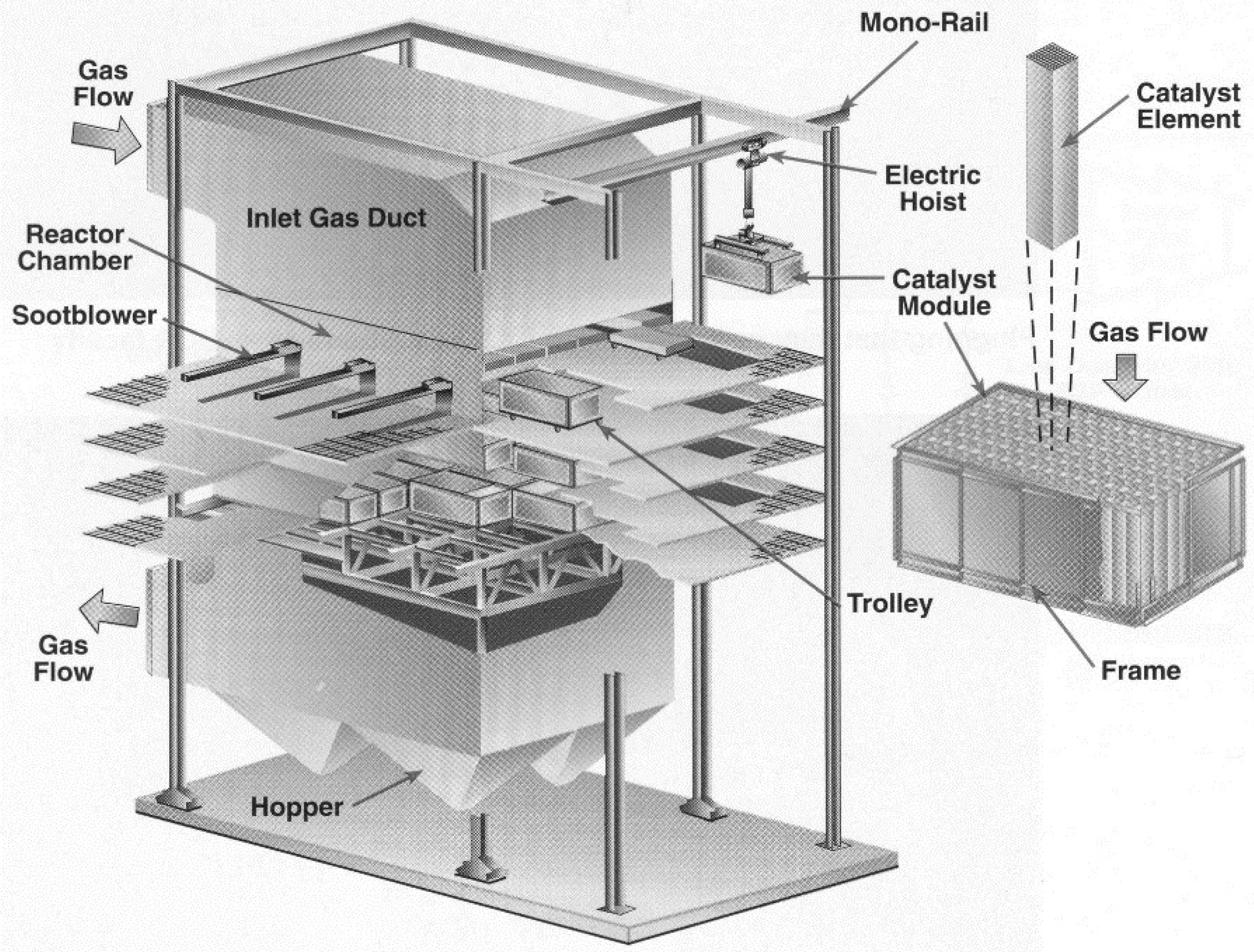 And this, put simply, is the magic that goes on inside of it, that visualizes the wonders of catalytically aided chemical, biological, biochemical and other [combined] processes: -outline-VECTORIZED-567x396-COPYRIGHT-PER-LINDELL-DO-NOT-COPY.png)
|
x o > |
||
| < | > | |||
| < |
> o x |
| < |
VEHICLE SHUNT REFUELLING CATALYTIC CONVERTERS  Imagine refuelling your car, your yacht, your plane ten times less often than today. Imagine driving ten times longer the distance before needing to refuel. And at less than one tenth the cost you pay today for your fuel !! Then widen your horizon, glance upward at a higher level, at even bigger perspectives — imagine this for every truck, lorry, bus, motorcycle, scooter, sea vessel, cargo ship, jet airliner, bulldozer, excavator or other diesel-fuelled piece of machinery on the planet. Cheap, totally climate neutral, eternally abundant energy for all of us for as long as we want! How could this vision come true ?? By reconverting a major part of your engine exhaust fumes into new fuel in a catalytic converter attached to your exhaust pipe, shunting the reconverted fuel back into your engine in a closed loop. Would that work ?? Definitely — just as fine as today's NO2+CO+HC* transforming (but not reshunting) catalytic converters, in many countries since decades mandatory underneath every car and truck. 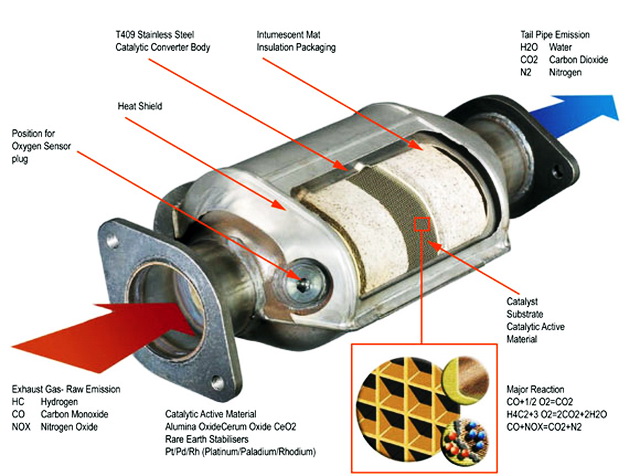 Feasible products could work in either end of today's mandatory converters, that eliminate concentrated car exhaust outlet NO2+CO+HC* at high temperatures and elevated gas pressure: 》 》 (A) inserting a Carbon resorbing catalytic converter step before today's converter step, i.e. between the engine and the NO2+CO+HC* converter 》 (B) inserting a Carbon resorbing catalytic converter step behind today's converter step, i.e. between the NO2+CO+HC* converter and the rear exhaust pipe (*) NO2 = nitrogendioxide, CO = carbonmonoxide, HC = [HxCx] hydrocarbons (residuals from fuel) Today's converters absorb nitrogen compounds like NOx produced by the engine combustion of the fuel + air mixture (Nitrogen N is abundant to 81% of the atmosphere). They also absorb residual hydrocarbons CxHx (or HxCx if you prefer) that due to incomplete engine combustion remains in the exhaust fumes. Last, the carbonmonoxide CO portion which catalytically converts into carbondioxide CO2. Advantages & disadvantages: 》 》 (A) + + + before... Implies that we're able to eliminate the entering two H2O oxidation and CO2 -> CO photocatalytic reduction steps. 》 (A) — — — before... The absorption process gets substantially harder in that NOx and CxHx impurities are interfering with the CO -> CxHx synthetic processes. 》 (B) + + + behind... The absorption process gets substantially easier in that NOx and CxHx impurities interfering with the CO -> CxHx synthetic processes are non-existant. 》 (B) — — — behind... Implies that the preceding converter step through its CO -> CO2 synthesis has rendered us a requirement for two additional, entering H2O oxidation and CO2 -> CO reduction steps. 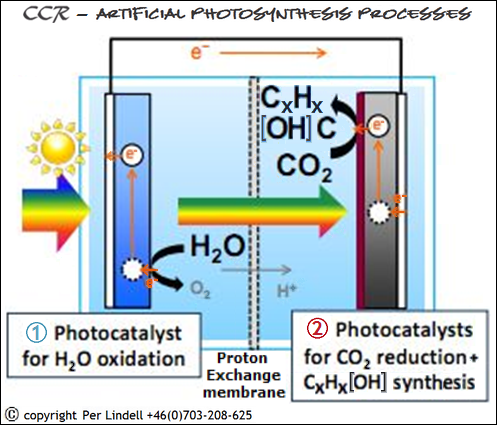
|
x o > |
||
| < | > | |||
| < |
> o x |
| |
CatELab-APS/e3 RESEARCH, SIMULATION & PRISM SOFTWARE Our CatELab-APS/e3 software will enable the elaboration of catalysts suitable for various conditions and applications: 》 》 diluted atmospheric and seawater-dissolved GHGs at various temperatures and at normal atmospheric - aquatic pressures 》 concentrated car exhaust outlet GHGs at high temperatures and elevated gas pressure (compare with today's NO2 + CO + HC* transforming catalytic converters, in many countries mandatory underneath every modern car) 》 concentrated industry and power plant smokestack GHGs at reduced temperatures and moderate pressure 》 any today not anticipated application dealing with any range of concentration, temperature and pressure 》 Also of course, adapted to the type of fuel the energy producer desires to output at any given facility or mobile catalytic converter setup (*) NO2 = nitrogendioxide, CO = carbonmonoxide, HC = [HxCx] hydrocarbons (residuals from fuel) This implies that we have designed our software to work with any given combined level of those four or five production conditions, be they high or low, dense or diluted, hot or cold, respectively. At the end of the day we aim to offer a software that can be managed in a simple way by non-scientist personnel, simply operated through intuitive web browser interface parameter calibrations of the anticipated transformation process input conditions as well as the desired outputs by turn. more coming soon!
|
x o |
||
| < | > | |||
o x |
| |
FleXray Anylyzer UTILITY SOFTWARE Our FleXray Anylyzer - Flexible X-ray Analyzer - utility software is an omnifarious & omnipotent utility software for analyzing anything, any way. This utlility is integrated into the Important Facts & Docs section. Its functionality can be applied to any data of any type, coming from any source. This utility is developed by us as a stand-alone software package easily integrable onto any set of information source - documents, calculation sheets, videos, audios, photos, graphics, animations, databases, webplaces, maps ... whatever — No "Big-Data"... c) : Works with any document format ... any video format ... any image format ... any raw data streaming in from anywhere, auto-structured by the reader function into crystal clear data and analyzed meeting your every need of clarity. So check it out and experience a new world of perceiving and dealing with... anything really... right at your fingertips, coming alive at your excited feet! This will turn you into a big-time juggler in total control - intuitively and with no effort. (the analyze functionality portion of this utility is available to FleXray subscribers and to CatELab licensees. Contact us for a demo and for additional information.) Stay tuned 4 addons! more coming soon!
|
x o |
||
| < | > | |||
o x |
| < |
AN UNPRECEDENTED ENERGY INVESTMENT OPPORTUNITY 
In the following I'll make evident to you how you can make an unprecedented and inconceivable gain on one position in the energy sector. The signals of success that none other can match will be obvious for you and for everyone else to see. But you have to get started early. This opportunity is so large — and so potentially lucrative — that it could pass you by in a matter of weeks. I’m talking about making pyramidal gains, but you can get started with a investment - tiny or substantial - to your preference. To understand exactly how big this opportunity is, we have to look back in history ... and you will see that every time a technology disrupts the energy industry ... BILLIONS are made by those who get in early. For example, have you ever seen one of these? 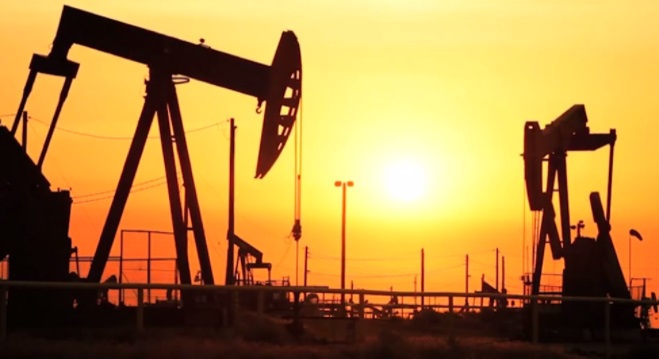 This big, ugly mass of metal that dominates the landscape of oil-rich states like Texas and California goes by many names. Some call it a nodding donkey. Others say it’s a rocking horse. While some call it a grasshopper pump. No matter what you call it, it’s a pumpjack, and it has one purpose: to excavate oil from the ground. When Walter Trout first invented the pumpjack in 1925, it was a massive disruptor to the oil industry. In short, it allows operators to extract oil that would otherwise remain untapped and extends the life of a well by several years. As a result, this pump made the Trout family extremely wealthy. In fact, the company Trout headed for decades, Lufkin Industries, the leading pumpjack-maker in the world, was recently acquired by GE Oil & Gas . . . for $3.3 billion. But this pales in comparison to the fortune made by the maker of this unusual-looking device...  It’s a rotary bit. It weighs 78 pounds, costs $3,500 and turns up to 100 times a minute. This bit was also a disruptor in the energy business ... it forever changed the oil industry. It essentially cracked the code to breaking through underground granite, allowing machinery to bore thousands of feet into a well. The man behind this revolutionary piece of machinery: Howard Hughes Sr. His company, Hughes Tool Co., which was left to his son Howard Hughes Jr. upon his untimely passing in 1924, held the patent on the tricone rotary bit for 17 years. During this time, Hughes’s market share was nearly 100%. This bit found almost all of the oil discovered during this era. And Howard Jr. became the richest man in the world. At the time of his death, Hughes’ net worth, in today’s dollars, was estimated to be $43 billion. A remarkable sum of money. Yet it’s puny compared to that of John D. Rockefeller. America’s first billionaire. In today’s dollars, Rockefeller’s wealth would be $318 billion. Of course, just like Trout and Hughes, he too made his fortune when he disrupted the oil industry. He did it through this... 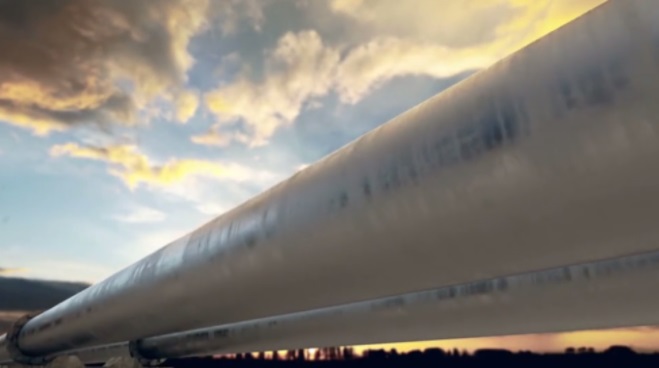 It’s an oil pipeline. A pipeline is the most efficient way to transport oil. Rockefeller knew that by owning the pipelines, he could control how much was paid for the oil that went into his refineries. By 1882, Rockefeller’s company, Standard Oil, controlled some 90% of America's refineries and had over 4,000 miles of pipelines. Standard Oil became the world’s first great industrial monopoly. And John D. Rockefeller became the richest man in the history of the world. The federal government broke up Standard Oil, but its spinoffs are still some of the biggest and most powerful oil companies in the world. ConocoPhillips, BP, Chevron and ExxonMobil all trace their roots back to John D. Rockefeller. These three disruptive innovations... The pumpjack The rotary bit The pipeline ...made billions for the Trout, Hughes and Rockefeller families ... and it made fortunes for shareholders with the vision to see that energy was the future. And now, once again, energy in the world is making an abrupt shift ... to a cleaner, cheaper and more abundant fuel ... a shift that will revolutionize the entire energy industry. And a company with technology that can efficiently tap this massive reserve above our heads and in the oceans and turn it into fuels and electricity is at the forefront of this energy resurgence. I am confident people who invest in our company will become very rich — and will have the opportunity to turn their investments into an absolute fortune. Today, as I’ll show you in a moment, our company’s breakthrough technology will finally make it possible to access this INFINITE SUPPLY of energy that’s cheaper, cleaner and more abundant than every fossil fuel. And not just cleaner, but in fact so clean it's cleaning all atmospheric and oceanic fossil waste surplus aggregation up! An Energy that will take the world by storm. For example, China predicts this fuel production system’s usage to grow exponentially. And The New York Times reports that “France is making a new push to develop [this] energy. The goal is to reduce carbon emissions ... while ensuring the nation’s energy independence.” Even less developed or coastal based and therefore vulnerable countries like Costa Rica are jumping in. Right now, we are in the early stages of a global transformation that simply wasn’t possible just a few years ago. And it’s all thanks to our powerful, unique software conducted technology. Some of the biggest energy-consuming countries in the world, including China, France, India, Japan and Russia have begun to show interest in deals. And I believe, if everything falls into place, once gone public our stock will hand early investors the opportunity to manifold their money in the months ahead. That’s millions of dollars for those who want in substantially, thousands for those in tiny. Before I tell you more about how to position yourself before the mainstream catches wind, it’s important to understand more about this energy and why it is the energy of the future. This powerful source of energy — that’s waiting to be tapped from above our heads and beneath the oceans' surface — is totally clean in its negative net carbon imprint (which implies purging air and water), cheap in its low production cost and current infrastructure utilization and more abundant than fossil fuel and every other energy commodity on Earth. At the time scientists began conceiving of the possibilies of recycling carbondioxide and other atmospheric or sea-soluble greenhouse gases, their work was met with much skepticism. You see, their findings needed one to believe that the man induced climate warming phenomenon exists. But that existence was not widely accepted for another 30 years. Yet it’s still the only non-utilized renewable energy on the planet. I’m talking about energy that is generated from fossil energy depots and that are combusted on the surface of the Earth, combining with atmospheric Oxygen in the process, rendering today 43 billion tons of new Carbon dioxide alone... not mentioning the leakage into the atmosphere of other greenhouse gases like recapturable and plainly reusable Methane. This energy is popularly called fossil energy. But that's just its origins behind the naming conventions. To us, a neutral and appropriate naming would be renewable hydrocarbon energy, or the likes. A Massachusetts Institute of Technology (MIT) study reveals there is enough energy in the atmosphere and beneath the oceans' surface to meet the world’s power needs FOR AS LONG AS WE WANT. And the U.S. Energy Information Administration reports that “the amount of energy in the atmosphere and in the oceans contains a manifold more energy than all the remaining FOSSIL coal, oil and natural gas resources in the world.” Until recently, this (non-renewable) hydrocarbon energy could only be brought to the surface from pumping it up off the ground. But now, thanks in no small part to our innovative company — and our remarkable “energy-mining” technology — this INFINITE SUPPLY of energy waiting to be harvested ... can start being tapped to power millions of homes, office buildings, airports ... and to start cleaning up the atmosphere, our oceans and lakes from a year-by-year increasingly detrimental and, future-wise predicted-to-be, fatal greenhouse gas surplus. I’ll tell you more about our company and how to profit from our breakthrough innovation in a moment, but before I get to that, I want to show you why those who act early could make an absolute fortune. But with panic soon to set in around our globe - redirecting all available assets to temporary bailouts like moving beaches up land and building enormous stretches of "protective" walls, at the expense of constructive R&D and development of REAL climate issue solving technologies - this is likely a Rapidly Closing Window of Opportunity. Therefore, we must all act with no further delay to save our future. Again, disruptive innovations in the energy sector are responsible for some of the greatest fortunes in history. The Trout family — inventors of the pumpjack — sold their company for $3.3 billion. Howard Hughes Jr. — who patented the rotary bit — left a $43 billion fortune. And John D. Rockefeller’s fortune — made from the oil pipeline — is worth an estimated $318 billion. As remarkable as these fortunes are, they pale in comparison to what you could make on the shift to the largest energy source the world has ever known. And while there will be a number of ways to profit in the coming years, there will NOT be another opportunity before you like the one that is here today. You see, the dawn of a new energy renaissance is upon us. And our remarkable — yet overlooked — technology and dawning company is at the forefront. If you were to make only one energy investment in the next decade, this should be the one. Because this is the incomparably most intelligent and concurrently RENEWABLE ENERGY SYSTEM conceivable. As I mentioned, there is enough energy to meet the world’s power demands literally for eternity, simultaneously enabling us to balance the atmospheric and aqueous rates of greenhouse gases in the air and in the water, reestablishing them at pre-industrial levels at our will. The absolutely best way to capitalize on this phenomenal opportunity is to invest in the one company that is developing the technology that will make this abundant energy accessible to the world ... and the rush to tap this INFINITE FUEL SUPPLY soon will be on. INFINITE BECAUSE as we UTILIZE the Carbon, hydrocarbons, and alcohol in combustion engines for transportation, power plants flue gas for electricity and heat generation, and industry flue gas for manufacturing, WE CONCURRENTLY PRODUCE waste (greenhouse) gases - namely the FEEDSTOCK, the raw material - which we subsequently recapture and transform into NEW FUELS in a perpetual cycle: combust - recycle - combust - recycle, and so forth. I am sure you already realize that CARBON IS ENERGY, irrespective of free as in Coal, or intrinsic in any compound, like CO2 Carbon dioxide, CH4 Methane and CxHx other liquid or gaseous hydrocarbons, and CxHxOH alcohols, plastics and other compounds. As you easily also realize, any Carbon reuse - retract cycle can go on forever, for eternity, perpetually, for as long as we like, for as long as we decide. And no Carbon - no ENERGY - is lost in the making. It all stays on the planet, in exactly the forms that we, i.e. THE MARKETS, decide we need it for from time to time. Just like today, only this time from clean origins - no sulphur dioxide (turning into sulphuric acid/ vitriol in contact with water) acicifying lakes, forests and farming lands, no heavy metal impurities to go around in our food chain supplies. Google is spending millions in heat-mining technology to fuel its campuses. This energy system would be perfect for them. Warren Buffett’s Berkshire Hathaway has invested millions in thermal heating, no doubt in my mind that with time he will turn to this instead. Many of the world’s biggest companies are doing everything they can to avoid paying the electric company every month ... as they shift to a cleaner, cheaper and much more efficient source of energy... Apple ... Amazon ... Tesla ... Walgreens ... Ikea ... Chevron... The list goes on and on. And it’s not just a phenomenon taking place in the United States. The biggest energy consumers in the world are shifting away from fossil fuels and into renewable energy. China ... Russia ... Mexico ... Italy ... Japan ... France... With our clean, cheap energy concept they could all revert to Hydrocarbons and Alcohols WITH A CLEAN CONSCIENCE and HEAPS OF MONEY LEFT in their wallets. But it comes down to this... The richest and smartest investors are kicking in their stalls and gnawing at their gates to be among the first into this CHEAP, CLEAN and INFINITE supply of energy. And our company is the one best-positioned to help them do it. For investors, the trend is just starting. I’m sure you remember what happened a decade ago, when a similar trend was underway ... when solar stocks were all the rage. When companies like First Solar skyrocketed from $26 to over $300... 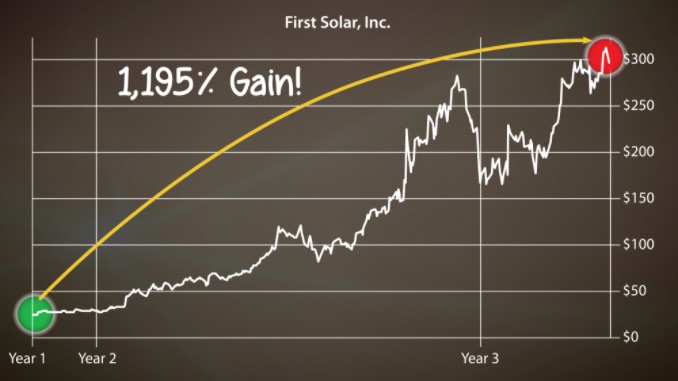 And early investors had the opportunity to make 1,195% gains. When SunPower took off... 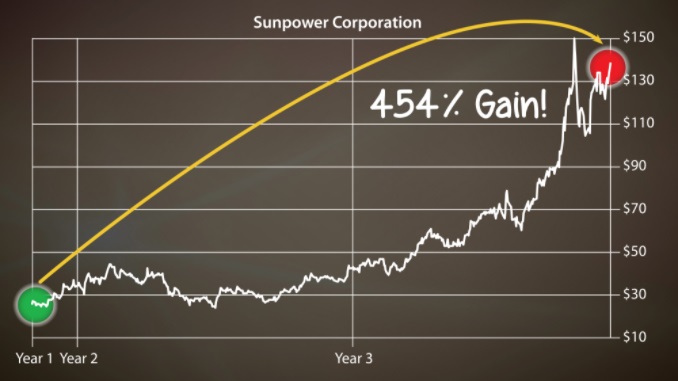 Going from $24 to $133 ... handing early investors 454% gains. And when Vestas Wind Systems surged... 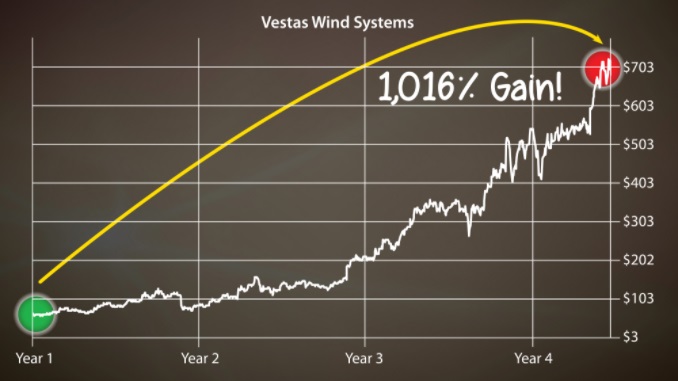 From $62 to $692 ... making investors with the vision to see the solar industry was on the cusp of a major surge a staggering 1,016% return. Well, I am absolutely certain that this massive energy revolution lead by us will make early investors even greater wealth. A revolution that could DWARF the solar gains of 1,195% ... 454% ... and 1,106%. And at the forefront of it all is an innovative company with the technology necessary to harness this greenhouse gas waste and turn it into clean fuels AT A LOW COST ... a company that I believe will give early investors the opportunity to make more than they dreamed off in return for their money in the months ahead ... and you can get started with any amount you like. I am confident investors with the foresight to invest in our company — before anyone else realizes how massive this opportunity is — will be rewarded greatly.
Only combustion waste "mining" has the potential to be MUCH BIGGER than Big Oil. Because unlike oil, which is only found in small pockets around the world ... waste gas energy can be found directly in the atmosphere, in smokestacks of power plants and industries, in sea and lake water, and in exhaust pipes of every diesel, gasoline (petrol) or kerosene propelled vehicle, vessel or aircraft. Again, coal, hydrocarbon and alcohol energy is not new — some of it has been a known and proven source of reliable energy for as long as our world has been industrialized. The only problem is, energy mining technology has only been able to harness its products from fossil sources. The company I represent has taken energy mining to a whole new level ... its energy mining technology can extract energy from anywhere on earth — from smokestacks, vehicle exhausts, atmosphere, lakes, and oceans. In the coming decade, I believe waste gas recycling energy — thanks to our company’s technology — will be the most widely used form of energy. All around the world. And this mega trend is beginning right now. Our R&D has led us to position our company where we are today, a company that stands to hand early investors the biggest profits.  CO2 & other greenhouse gases in the atmosphere, lakes & oceans imply Big-Time Money just waiting for Us to be harvested!! Formed in 2013, our company’s CEO is an IT and industry veteran, and he’s using his contacts to lock in some stellar contracts... Investing in this corporate pioneer today could position you perfectly to enjoy a ride on the greatest energy renaissance the world has ever seen. In the last few months, our company's energy system concept has gained global recognition as corporations and institutions in i.a. Malaysia, the Philippines, Australia, New Zealand, French Polynesia and the Republic of Fiji have all shown interest in learning all they can about our computer simulation based Energy Mining technology. Fact is, it’s impossible to project just how massive the gains for early investors here could be, because we’ve never seen a situation quite like this before. A situation where one company is so integrated in nearly every phase of the waste gas "mining" process that it is likely to grow proportionately with the niche itself. And, while nothing in the market is guaranteed, even a fraction of the success we predict would be enough to be life-changing. Perhaps now you can see why I am convinced our company will soon dominate not just the fossil replacing fuels industry, but the entire energy sector itself. And why I believe our turnover and future stock will take off. Early investors in solar stocks saw gains of 1,195% ... 454% ... and 1,106%. And I have no doubt this will be an even more lucrative opportunity for investors who take action early. Investing in our company is simple. You may opt between closing a Personal Investment Deal, purchasing Equities, and/or joining our Crowd Funding Campaign. You may also wish to Sponsor us, Donate, and/or Place Ads at our Corporate Website. A personal investment deal —> Through a personal meeting face-to-face, over Skype or other video link, over the phone, or via email. Purchase Equities —> You need to sign up, whereby you can fill in any personal details to your liking — all we really need at this point is your login-id (email-adress) for verifying you on your purchase details. Equity purchases are most easily made via PayPal — all you need to supply us with, along with the payment, is your login-id (but of course NOT the password for it). When later you wish to withdraw (some or all of) your equity balance, you'll notify us supplying your login-id along with payment details — however if you made the purchase via PayPal, we already have your PayPal account id for forwarding our repayment (you are however of course free to specify another account or transaction method for this). All equities are payable in Euros (EUR), US Dollars (USD), or Swedish Kronor (SEK). Our Equity Model is found under top meny "mission/models". As later we go public, our shares will be traded over the Stock Exchange ("SE"), whereby we will offer you to keep your equities (traded as described), or to convert them into shares traded over the SE. Take care now => & Take action a$ap ... Sincerely, Mr Per lindell CEO & founder of ACES - Acwareus Climate-Energy Solutions. 
|
x o |
||||||||
| < | ||||||||||
| < |
o x |
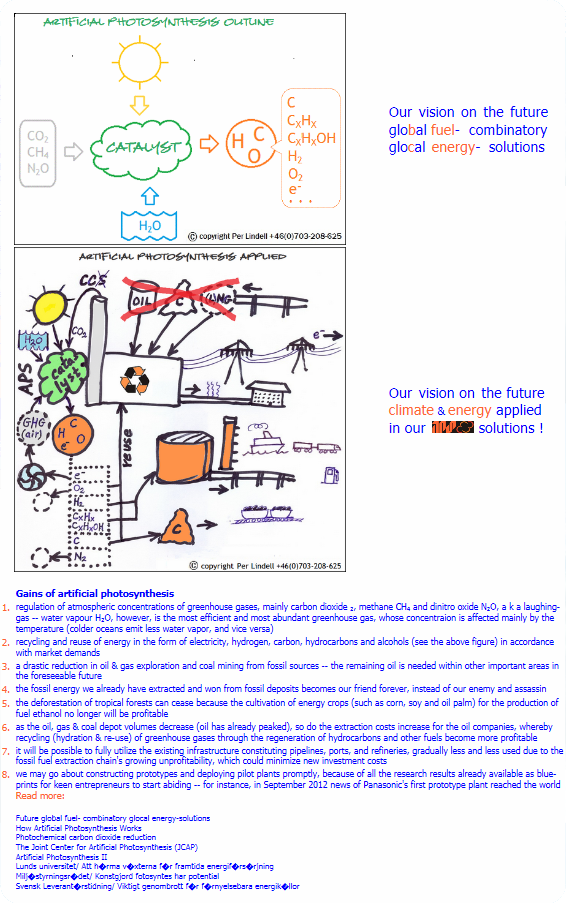
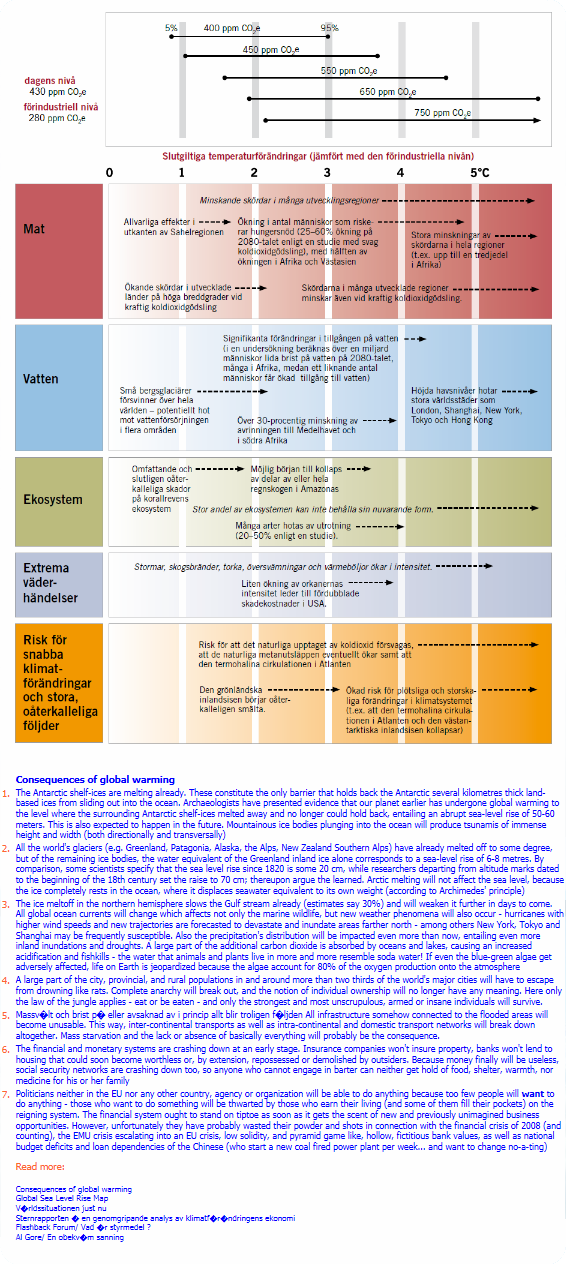

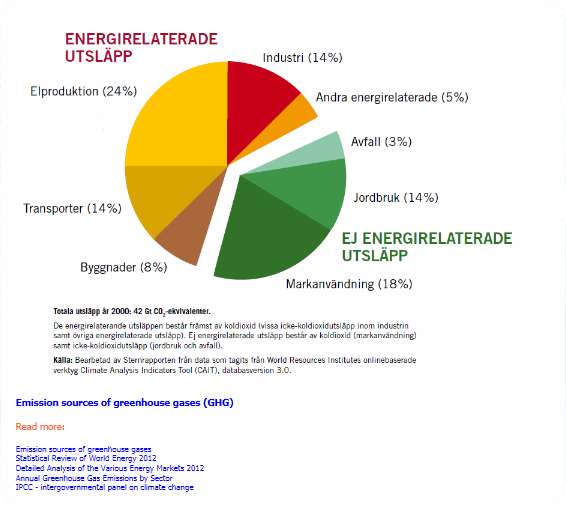
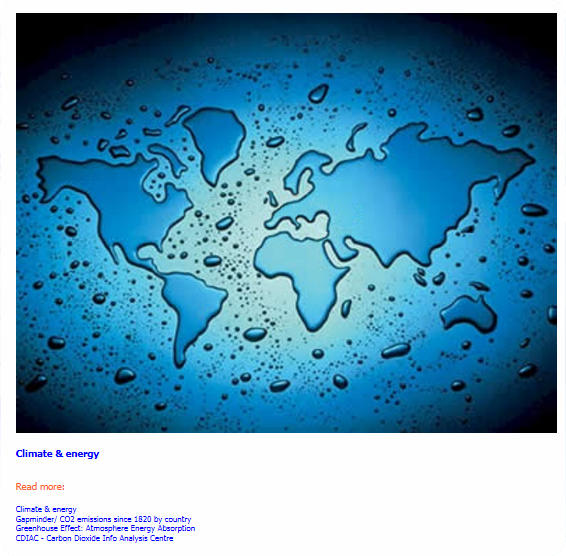


|
-outline-VECTORIZED-567x396-COPYRIGHT-PER-LINDELL-DO-NOT-COPY.png) |
Vår vision om framtidens globala drivmedels- och glokala energi- lösningar |
|
-applied-VECTORIZED-541x531-COPYRIGHT-PER-LINDELL-DO-NOT-COPY.png) |
Vår vision om framtidens klimat & energi tillämpad i våra |
| Vinster med artificiell fotosyntes | |
| 1. | reglering av atmosfärens halt av växthusgaser, vilka framför allt är koldioxid CO2, metan CH4 och lustgas (dikväveoxid) N2O -- vattenånga H2O är dock den effektivaste och samtidigt vanligast förekommande växthusgasen, vars halt påverkas framför allt av temperaturen (kallare hav avger mindre vattenånga, och tvärtom) |
| 2. | återvinning och återanvändning av energi i form av elström, vätgas, kol, kolväten och alkoholer (se figuren ovan) alltefter marknadens efterfrågan |
| 3. | drastisk minskning av olje- & gasutvinning samt kolbrytning från fossila källor - den kvarvarande oljan behövs inom andra viktiga områden inom överskådlig tid |
| 4. | den fossila energi vi redan utvunnit och brutit ur fossila depåer blir vår vän för all framtid, i stället för vår fiende och baneman |
| 5. | skövlingen av regnskogarna kan upphöra eftersom odling av energigrödor (t ex majs, soja och oljepalm) för tillverkning av fordonsetanol inte längre blir lönsam |
| 6. | i takt med att olje-, gas- & koldepåerna minskar (oljan har redan "peakat") så ökar utvinningskostnaderna för oljebolagen, varvid recycling (återvinning & återanvändning) av växthusgaser genom regenerering av kolväten och andra bränslen blir mera lönsam |
| 7. | det blir möjligt att fullt ut utnyttja befintlig infrastruktur i form av pipelines, hamnar och raffinaderianläggningar som successivt utnyttjas allt mindre p g a den fossila utvinningens tilltagande olönsamhet, vilket kan minimera nya investeringskostnader |
| 8. | det bör gå snabbt att bygga prototyper och pilotanläggningar eftersom alla tillgängliga forskningsresultat redan ligger där som rena blueprints för hugade entreprenörer att börja bygga efter - i skrivande stund (sep/2012) har nyheten kommit om Panasonic som de första att bygga en prototypanläggning Läs mer: Framtidens globala drivmedels- & glokala energi-lösningar How Artificial Photosynthesis Works Photochemical carbon dioxide reduction The Joint Center for Artificial Photosynthesis (JCAP) Artificial Photosynthesis II Lunds universitet/ Att härma växterna för framtida energiförsörjning Miljöstyrningsrådet/ Konstgjord fotosyntes har potential Svensk Leverantörstidning/ Viktigt genombrott för förnyelsebara energikällor |


|
Konsekvenserna av global uppvärmning |
| 1. | Antarktis shelf-isar smälter redan. Dessa utgör det enda hindret som håller tillbaks Antarktis flera km tjocka landisar från att kana ut i havet. Arkeologer har presenterat bevis för att det tidigare i jordens historia har skett en uppvärmning till den nivå där Antarktis shelf-isar smält bort och inte kunnat hålla emot, med en abrupt havsnivåhöjning på 50 - 60 meter som följd. Så förväntas också komma att ske i det kommande. När stora ismassor vräker sig ut i havet kommer tsunamis av enorm höjd och vågbredd (både i utbrednings-riktningen och transversellt) att skapas |
| 2. | All världens glaciärer (Grönland, Patagonien, Alaska, Alperna, New Zealand Southern Alps) har redan smält av till viss del, men av resterande ismassor motsvarar vattenekvivalenten i enbart Grönlandsisen en havsnivåhöjning på 6 - 8 meter. Som jämförelse anger en del forskare att havsnivåhöjningen sedan 1820 ligger på 20 cm, medan forskare som utgått från höjdmärken daterade till början av 1700-talet anger höjningen till 70-80 cm; därom tvista de lärde. Arktis avsmältning påverkar f ö inte havsnivån eftersom den ismassan helt ligger i havet och där tränger undan havsvatten motsvarande sin egen vikt (i enlighet med Archimedes princip) |
| 3. | Isavsmältningen i den norra hemisfären bromsar redan nu Golfströmmen och kommer ytterligare att försvaga den framöver. Världshavens alla havsströmmar kommer att förändras vilket påverkar inte bara djurlivet utan nya väder- fenomen kan också uppstå - orkaner med allt högre vindstyrkor och nya banor är prognosticerade att ödelägga och översvämma områden allt längre norrut - bl a New York, Tokyo och Shanghai kan drabbas frekvent. Också nederbördens fördelning kommer att påverkas än mer än redan hittills, med ännu mer inlandsöversvämningar resp torka som följd. En stor del den tillkommande koldioxiden absorberas av hav och sjöar, med ökad försurning och fiskdöd som följd - vattnet som djur och växter ska leva i liknar mer och mer vichyvatten! Ifall även de blå-gröna algerna påverkas negativt är livet på jorden i fara eftersom de algerna står för 80% av syreproduktionen ut till atmosfären |
| 4. | En stor del av stads-, landsorts- och lantbefolkningen i och runt mer än två tredjedelar av världens större städer kommer att få fly från att dränkas som råttor. Fullständig anarki kommer att bryta ut, och begreppet enskilt ägande kommer inte längre att ha någon innebörd. Här gäller bara djungelns lag - äta eller ätas - och bara de starkaste och mest skrupellösa, beväpnade eller galna individerna överlever |
| 5. | All infrastruktur som på något sätt har koppling till översvämmade områden kommer att bli oanvändbar. På detta sätt kommer inter-kontinentala transporter likaväl som intrakontinentala och inomnationella transportnät att helt bryta samman. Massvält och brist på eller avsaknad av i princip allt blir troligen följden |
| 6. | De finansiella och monetära systemen brakar ihop på ett tidigt skede. Försäkringsbolag vill inte försäkra egendom, banker vill inte låna ut till bostäder som snart kan bli värdelösa eller i förlängningen övertagna eller demolerade av utomstående. Eftersom pengar slutligen blir värdelösa kan den som inte kan idka byteshandel heller inte få tag på mat, tak över huvudet, värme och medicin till sin familj |
| 7. | Politiker varken inom EU eller i något annat land eller samarbetsorgan kommer att kunna göra något eftersom alltför
få kommer att vilja göra något - de som vill göra något kommer att motarbetas av dem som tjänar sitt levebröd (och en del av
dem fyller sina fickor) på det rådande systemet. Finanssystemet borde ställa sig på tå så snart det får vittring
på nya och hittills oanade affärsmöjligheter. Dock så har de dock nog dessvärre bränt sitt bästa krut i och med
finanskrisen 2008 (and counting), EMU-krisen som eskalerar till en EU-kris, låg soliditet och pyramidspelsliknande,
ihåliga och fiktiva bankvärden, samt statliga budgetunderskott och låneberoenden av kineserna (som startar ett nytt
kolkraftverk per vecka... och vill ändra på ing-en-ting)
Läs mer: |

|
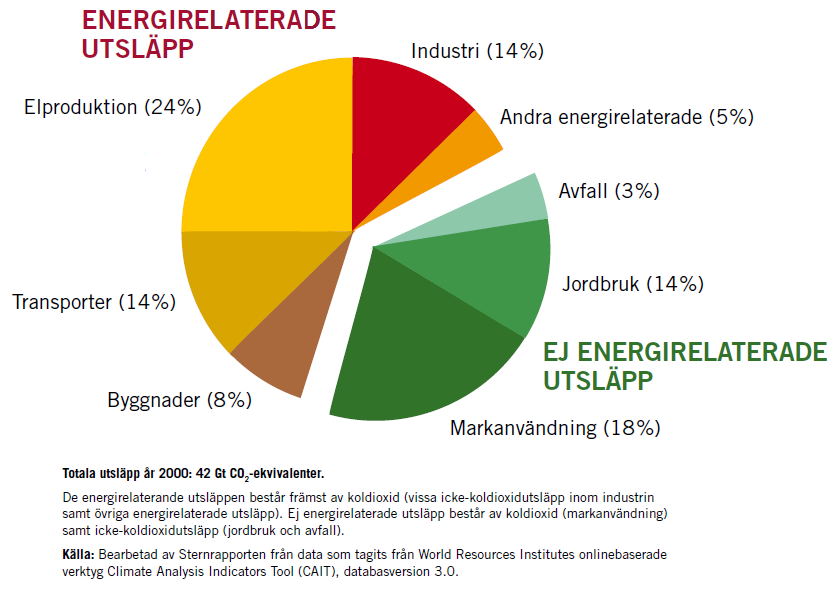
|
| Utsläppskällor för växthusgaser | |
| Läs mer: Utsläppskällor för växthusgaser Statistical Review of World Energy 2012 Detailed Analysis of the Various Energy Markets 2012 Annual Greenhouse Gas Emissions by Sector IPCC - intergovernmental panel on climate change |

|

|
| Klimat & energi | |
|
Läs mer: |

|
Världens stadsbefolkningar i riskzonen för översvämning |
Source: Coastal Analysis Data Set utilizing GRUMP beta population and land area grids (CIESIN, 2005),
Low Elevation Coastal Zone created from SRTM elevation grid (CIESIN, 2006)
LECZ = Low Elevation Coastal Zone
LECZ: land area that is contiguous with the coast and 10 meters or less in elevation.
Region Urban population LECZ Population Urban population in LECZ % of LECZ urban % of urban in LECZ
(millions) (millions) (millions) to total urban
Africa Total 282 56 32 11.5% 58.2%
Northern Africa 88 30 16 17.6% 50.6%
Sub-Saharan Africa 194 25 17 8.7% 67.6%
Asia total 1431 450 235 16.4% 52.3%
Eastern Asia 709 160 109 15.4% 68.4%
Southern Asia 415 141 56 13.5% 39.7%
South-Eastern Asia 169 137 61 36.2% 44.6%
Western Asia 103 11 8 8.3% 73.9%
CIS Asia 35 .1 .1 0.3% 61.0%
LAC 320 34 25 7.7% 73.4%
Oceania 2 .9 .4 21.9% 51.9%
Developing Total 2035 540 293 14.4% 54.2%
Europe (inc. CIS Europe) 501 50 40 7.9% 79.1%
N.America 256 24 21 8.4% 88.7%
Japan 102 29 28 27.0% 93.8%
Australia & New Zealand 18 3 2 13.5% 85.1%
Developed Total 877 107 91 10.4% 85.5%
World total 2911 647 384 13.2% 59.4%
|
|
| Sårbarhet för översvämning (basinfo - join in & team up för komplett version) Jordens större kuststäder med antal miljoner invånare (2010) i området |
|
Europa: London (GBR) - 13 Hamburg (GER) Köln (GER) - 3 Marseille (FRA) - 2 Nice (FRA) Monaco (MON) Barcelona (ESP) - 3 Rom (ITA) Venedig (ITA) Vatikanstaten (VAT) S:t Petersburg (RUS) - 5 Murmansk (RUS) Stockholm (SWE) - 2 Köpenhamn (DAN) - 2 Oslo (NOR) - 1 Helsinki (FIN) - 1 Reykjavik (ISL) Dubrovnik (CRO) Pula (CRO) Aten (GRE) - 3 Istanbul (TUR) - 10 Izmir (TUR) Riga (LAT) - 1 Vilnius (LIT) - 1 Tallinn - 1 ... USA: New York - 20 Los Angeles - 15 Boston Norfolk Philadelphia - 5 Baltimore Washington, DC - 4 Atlantic City Miami San Francisco - 4 Seattle San Diego New Orleans Anchorage Honolulu ... Västindien: Havana (CUB) Port au Prince (HAI) San Juan (DOM) ... Canada (CAN): Vancouver ... Centralamerika: Tijuana (MEX) Panama City (PAN) ... Sydamerika: Sao Paolo (BRA) - 19 Rio de Janeiro (BRA) - 11 Belem (BRA) Itaquari (BRA) Salvador (BRA) - 3 Porte Alegre (BRA) Fortaleza (BRA) Buenos Aires (ARG) - 13 Ascunsion (URU) Paraguay (PAR) Lima (PER) - 8 Guayaquil (EQU) ... Kina (CHN): Shanghai - 17 Hong Kong - 6 ... Japan (JPN): Tokyo - 33 Osaka-Kobe - 17 Kyoto Sapporo ... Indien (IND): Mumbay - 19 Delhi - 19 Chennai - 7 Calcutta - 15 ... Övr Asien: Karachi (PAK) - 12 Bangkok (THA) - 7 Singapore (SIN) Kuala Lumpur (MAL) Rangoon (BUR) Dhaka (BAN) - 11 Chittagong (BAN) Colombo (SRL) - 2 Taipei (TWN) Seoul (KOR) - 21 Ho Chi Minh City (VIE) - 7 Hanoi (VIE) - 4 Jakarta (INA) - 19 Manila (FIL) - 16 ... Australien (AUS): Sydney - 4 Melbourne - 3 Brisbane Adelaide Perth ... Afrika: Alexandria (EGY) - 4 Bur Said (EGY) AlMahallah alKubr (EGY) Tarabulus (LIB) Tunis (TUN) Alger (ALG) - 5 Casablanca (MAR) - 4 Dakar (SEN) Conakry () Abidjan (CIV) Accra () ... (NIA) Freetown (SIL) - 2 Lagos (NIG) - 14 Douala (ZAI) Luanda (KON) - 2 Kayamnandi (RSA) Kapstaden (RSA) Port Elizabeth (RSA) Durban (RSA) Mombasa (KEN) Maputo (MOZ) - 3 Dar-es-Salaam (ZIM) Cotonou (BEN) Jerusalem (ISR) Jeddah (SAR) ...
Läs mer:
|
|

|
Acwareus.com |  |
we're that wonderwall for wonderworks |
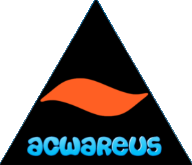
|
| Climate-Energy |  |
sustainable engineering above the mark | ||
| CatELab-APS/e3 |  |
in real life the only responsible solutions |
|
Kontakt 46(0)767 814 910  skype: acwareus contact@acwareus.com öppna kontaktformulär |
Engagemang donation, annons, partnerskap, medlemskap, sponsor eller equity/andel förfrågan, fakta, idéer & frågor välkomna |
Betalning PayPal-betalning Bankgiro 876-4169 Iban SE39500000000CLNRACCOUNT Bic/Swift ESSESESS |
|
  
|
copyright © Acwareus.com 2013-: Acwareus Climate-Energy Solutions Corp. |
 
|
|
| Acwareus mission & vision |

|
|
» Mission & vision » skapa opinion, och därigenom en efterfrågan som skapar en marknad för recycling (återvinning) av energi ur växthusgaser. » skapa ett aldrig sinande kretslopp från kolväte-baserade bränslen till växthusgaser tillbaka till kolvätebaserade bränslen igen och igen. » hjälpa företag tjäna pengar och samtidigt möjlig-göra en reglering av atmosfärens halt av växthus-gaser för att förhindra en total katastrof. » erbjuda forskare & marknadsaktörer |



|
|
|
|
| Acwareus idé & incitament modell | 
|
|
» Idé & incitament » Du vill ha information och vill delta i en positiv klimat-/energiutveckling » bli (gratis) medlem i Acwareus » Stigande medlemsantal & målgruppsinriktad marknadsföring » intresse för att genom annonsering vilja synas här » Privatpersoner & andra investerare tror på stor marknadspåverkan & stark affärsutveckling » köp av equities med chans till hög ROI » Företag & andra organisationer samt privatpersoner vill profilera sig » sponsring & donation som en hjärtefråga och/eller för goodwill, publicitet, reklam & förmåner » Ökande hype, leasing av CatELab-APS/e3 verktyg för forskare & marknadsaktörer tar fart, märkbara konkurrensfördelar för annonsörer, sponsorer & övriga involverade, spridning via sociala medier & massmedial täckning ökar intresset » fler medlemmar som vill va med & få veta mer » Nytt varv med aggregerade antal medlemmar, annonsörer, equity-köpare, sponsorer & donatorer » insiktsspridning, efterfrågetryck, marknadspåverkan, affärsincitament o s v varv efter varv » Vid en viss punkt börjar verksamheten ge utdelning i termer av efterfrågetryck & marknadspåverkan » växande antal forskar-communities dedicerade mot olika APS/e3 lösningar, entreprenader för prototyping & piloting växer fram, positiva resultat lockar t ex oljebolag, och voilà - mission accomplished! |
|
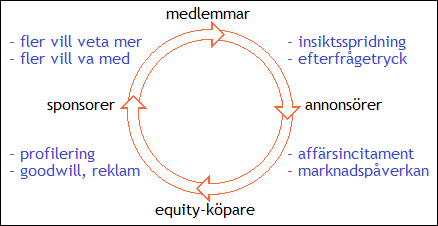
|
|
| Acwareus equity modell |

|
|
» Equities » Den årliga nettoavkastningen* är dels en grundpott som utgör hälften av fjorårets totala annons- och sponsorintäkter (frånräknat skatter och självkostnader*), och dels en bonuspott bildad av andra hälften. » Grundpotten fördelas på senaste årsskiftets totala antal equities (härefter "eqs") på sådant vis att värdet på varje helårsägd equity ("eq") årligen kan öka med upp till 50%, beroende på totalt antal sålda eqs. » Om antalet eqs i proportion till nettoavkasningen är så lågt att alla eqs tillsammans inte kan absorbera den del av nettoavkastningen som överstiger maxtaket, så buffras överskottet för att fördelas på equities kommande (ett eller flera) år då taket inte nåtts. » Efter samma princip fördelas också bonuspotten, till hälften på var femte (1 av 5) eq resp till hälften på var tjugonde (1 av 20) eq. » Exempel: om totala antalet eqs (à 10 SEK** köpeskilling) är 1000 st och nettointäkterna (inkl ev uttag ur buffert) är 10.000 SEK eller mer (kvoten 1 till minst 10***) så blir det maxavkastning det året » 5000 SEK till grundpotten » 5000 / 1000 eqs » 5 SEK för varje eq, resp 5000 till bonuspotten » 2500 (= 1/2 av 5000) / 200 eqs (= 1000/5) » 12,5 SEK för var 5:e eq, samt » 2500 (= 1/2 av 5000) / 50 eqs (=1000/20) » 50 SEK för var 20:e eq. » Således, om du äger 20 eqs blir, beroende på kvoten antal eqs / nettointäkter, avkastningen i SEK per eq & år upp till: 5-5-5-5-17,5-5-5-5-5-17,5-5-5-5-5-17,5-5-5-5-5-67,5 (Summa: 16*5 + 3*17,5 + 1*67,5 alt 20*5 + 4*12,5 + 1*50 = 200 SEK för varje 20-post till 200 SEK inköpspris). » Vid helårsinnehav blir per eq-post (inköpspris inom parentes) årlig maxavkastning i SEK resp i procent t ex: 1-(10)-5-50%, 5-(50)-37,5-75%, 20-(200)-200-100%. En multipel faktor eqs matchar samma multipla faktor årsavkastning, t ex: 10-(100)-50-50%, 50-(500)-375-75%, 200-(2000)-2000-100%. » Värdet av en eqs årsavkastning aggregeras till dess nominella grundvärde (inköpspriset 10 SEK) och avkastning från ev tidigare år. » Grundvärdet är alltid oreducerat. Årsavkastningsandelen är oreducerad vid helårsinnehav och reducerad med årsandelen av dagar som fattas vid delårsinnehav. » Vid equity-ägares försäljning av eqs återbetalar vi i turordning hela deras innevarande värde (saldot vid senaste årsskiftet) så snart medlem(mar) köper ny(a) eq(s) till minst samma antal som aktuellt försäljningsantal, dock senast i slutet av därpå följande halvår (sålt 1:a halvåret » återbet senast 30 dec samma år; sålt 2:a halvåret » återbet senast 30 juni året därpå). *Ersättningar för egenutveckling av programvara & databank, forskningsomkostnader, medlemssupport och ev resande, alla i tjänsten. Fonderade och buffrade saldon liksom alla intäkter, kostnader och nuvarande antal eqs resp antalet vid senaste årsskiftet redovisas öppet. Donationer fonderas i vår stiftelse för egna och andras insatser på området, och dessa med deras användning redovisas i enlighet med ev donationsvillkor. ** Eller ekvivalent, se bizz model för gällande växelkurser. *** Du kan påverka avkastningsgraden och förstärka en positiv spiral: köp equities så » ökar sajtens popularitet varigenom » annonseringen ökar, med » ökade annonsörsvinster som följd; annonsera så » ökar sajtens popularitet varigenom » equityköpen ökar, med » ökade reella equityvinster och därigenom » ökad annonsering som följd, o s v, o s v. var god uppge ditt medlemsnr & namn/alias i alla meddelanden till oss |
|
| Acwareus info modell | 
|
|
basinfo » medlem utökad info » annonsör/ partner/...* komplett info » equity-(andels-)ägare* + verktyg » CatELab-APS/e3 kund * ju fler equities desto mer info |
|
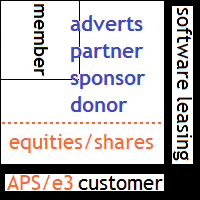
|
|
| Acwareus bizz modell |

|
|
nationella betalningar » bankgiro 876-4169 internationella Bic/Swift » ESSESESS Iban » SE39500000000CLNRACCOUNT var god uppge ditt medlemsnr & namn/alias |
|

|
|
| APS/e3 konceptskisser |

|
|
APS - artificiell fotosyntes som konceptskiss resp tillämpning: Vår vision om framtidens globala drivmedels- & glokala energi-lösningar |
|
-outline-VECTORIZED-567x396-COPYRIGHT-PER-LINDELL-DO-NOT-COPY.png)
|
|
|
Vår vision om framtidens klimat & energi tillämpad genom våra |
|
-applied-VECTORIZED-541x531-COPYRIGHT-PER-LINDELL-DO-NOT-COPY.png)
|
|
| « Läs mer » | |
| förlorade paradis och nationer |

|
|
Scenarier för havsnivåhöjning: 1:a vågen (1 m) » förintar "paradisöar" (raderar för alltid bort de flesta av flaggorna på kartan nedan) och översvämmar kustregioner och många kuststäder världen runt vid stormvindar 2:a vågen (2 m) » vattenfyller de kanske flesta kuststäder, låglänta nationer som Bangla Desh & Nederländerna vid höga tidvattennivåer och stormar, sveper bort och avfolkar de Karibiska, Stillahavs, Atlantiska & Indiska övärldarna och gör hamnar obrukbara, varigenom omöjliggörs gods- & passagerar-sjöfart 3:e vågen (3 m) » dränker varje kuststad och den mesta kustnära sjö- eller landbaserade infrastrukturen världen över, och dränker nationer som Danmark och Australien, öar som Irland, Sicilien, Sardinien, ... 4:e vågen (...) » involverar verkliga vågor, nämligen enorma tsunamis skapade av att kanande isberg från Antarktis vältrar ner i havet - allt sagt & gjort orsakande uppåt 70 meters havsnivåhöjning |
|

|
|
| CatELab & APS/e3 integrerade processer |

|
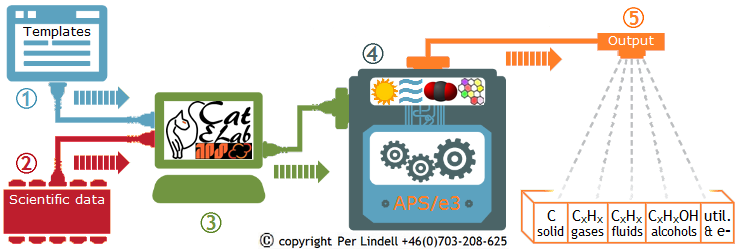
|
|
|
CatELab forskningsverktyg integrerat med APS/e3 i iterativa, varaktiga, klimatneutrala processer: Regler, mönster, (kor)relationer, förbindelser, formler etc som kan appliceras på data av olika slag i enlighet med vetenskapliga fakta och forskningsresultat eller andra slutsatser med baserade på valfritt område. CatELab-APS/e3 importerar, utnyttjar och förenklar formulerandet av nya Templates oavsett typ, användning och komplexitet. Vetenskaplig och annan typ av data, lagrade i databasen integrerad i CatELab-APS/e3, eller extraherade från Internet i realtid, inlänkade i Simulatorn eller i Template Managern på varje nivå och exekveringssteg. "Reaktorn" för simulering på parametrar omfattande Scientific data (2), Templates (1), temperatur, tryck, ev magnetfält, ev elektromagnetisk strålning, ev icke-katalytisk dopnings- eller annan nano-substans etc, för att identifiera lämpliga katalytiska kandidater till produktion av olika skräddarsydda bränslen eller andra produkter, ur växthusgaser (framför allt CO2) i processer baserade på Applied Artificial PhotoSynthesis (APS) - tillämpad artificiell fotosyntes. Lämpligheten hos varje katalytisk kandidat graderas efter dess förenlighet med tvingande standards utgörande (utväxlingen av) energi, ekonomi and ekologi (e3) såsom en oseparerbar triangulär ram för marknaden. Programvaran hanterar också databaser och andra datasets, mappningar från datakällor på internet etc (2), hanterar Templates (1), samt kalibrerar, mäter, utvärderar och kontrollerar processer (4), sparande alla data associerade med dessa tillsammans med labmiljöfaktorer. APS/e3 processer utnyttjar Applied Artificial PhotoSynthesis (APS) - tillämpad artificiell fotosyntes, och hämtar följande input: Solljus, Vatten (ur havet), Koldioxid (atmosfärisk eller ur skorsten), Katalysator(er). Resulterande process-outputs är bränslen och andra produkter. • Rent Kol (C) i fast form för kraftverk och industrier. • Gasformiga Kolväten (CxHx) såsom Metan, Etan, Propan och Butan. • Flytande Kolväten (CxHx) såsom Hexan, Bensen, Fotogen/Paraffin och tyngre föreningar. Bensin är en blandning av ett femtiotal molekylära föreningar, Diesel innehåller tyngre molekyler. • Flytande alkoholer såsom Metanol, Etanol, Propanol och bi-alkoholiska föreningar såsom DME (gasformig) och tyngre, flytande sådana. • Nyttoprodukter såsom plaster, mediciner, gödningsämnen, byggnads- och andra konstruktionsmaterial, polymerer, vaxer, mascara, smörjfetter, tjära, asfalt och mycket mer. T o m electricitet kan produceras som en biprodukt till vissa processer. Rent Väte (H2) produceras enkelt genom genom delning av vatten i elektrolys (oxidation/reduktion) utan katalysator, kanske bäst driven av vind- eller solkraftselektricitet. Dock är Väte inte lämpat som bränsle annat än i kraftverk eller industrier direkt anslutande till där det produceras. |
|
| « Läs mer » | |
| CCR - APS processer |

|

Schematic conceptual view of photocatalyst oxidation & photocatalyst reduction + synthesis processes |
|
|
Catalyst induced processes in Artificial PhotoSynthesis applying our concept of CCR - Carbon(dioxide) Capture and Recycling (or Reprocessing/Regeneration/Reactivation/Reuse/...)
Our CatELab-APS/e3 catalyst elaboration/E-Lab simulation software embodies a science-based simulation "reactor" kernel and a virtual lab which emulates any imaginable laboratory setup and configuration found or conceived in the real world. It elaborates GHG-to-fuel CCR transformed conversion processes by tailoring the catalyst required for meeting the producer's desired fuel type output in any given inter-combined environmental condition setup with respect to GHG compound and density, temperature and pressure. All is achieved in separate but integrated process steps: This step is however not mandatory for the ensuing second dual-step-process to come alive, while the H2O (water) split that occurs in step 1 easily and often favorably could be substituted for hydrogen plus-ion production by means of electrolysis of water, yielding an identical result: feeding H+ ions into step 2 processes. 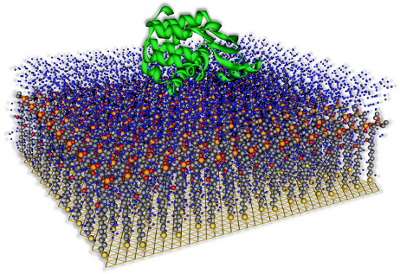
Photocatalyst oxidation & photocatalyst reduction + synthesis processes as viewed in CatELab-APS/e3 virtual simulator 3D-model The fulfilment of input requisites is also allied with the competitive market prices for each type of fuel produced -- supplying the right energy market product is fine, doing it from GHGs - thereby cleaning out the atmosphere from their detrimental impact - is super. But only so long as it is produced and put on sale at a competitive price. The market alone will decide how competitive any output product will prove to be. Customers may well find themselves motivated to pay more for clean fuels, just like some of us fancy even expensive organically grown foods, but in order to truly bring about a change in terms of an adequate atmospheric cleanup, putting a halt to acidification, ice meltoffs and climatic catastrophes, we need to attract the vast majority that often primarily consume what comes at the best price. Low production costs and utilization of existing distribution infrastructure is the best way to ensure this, hence not founding any hopes on political decisions like tax regulations or product subsidizing. 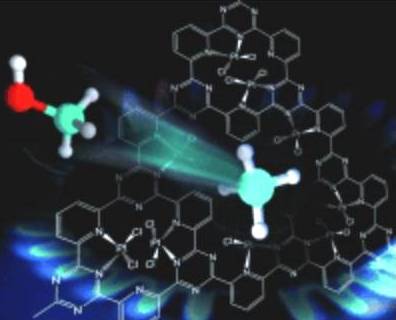
CatELab-APS/e3 simulator virtual 3D-model showing a solid heterogenous surface catalyst in action while converting methane into methanol by means of an injected catalyst or series of catalysts Our CatELab-APS/e3 software will enable the elaboration of catalysts suitable for various conditions and applications: diluted atmospheric and seawater-dissolved GHGs at various temperatures and at normal atmospheric - aquatic pressures; concentrated car exhaust outlet GHGs at high temperatures and elevated gas pressure (compare with today's nitrogen transforming catalytic converters, mandatory underneath every modern car); concentrated industry and power plant smokestack GHGs at reduced temperatures and moderate pressure; any today not anticipated application dealing with any range of concentration, temperature and pressure. Also, of course adapted to the type of fuel the energy producer desires to output at any given facility or mobile catalytic converter setup. This implies that we have designed our software to work with any given combined level of those four production conditions, be they high or low, dense or diluted, hot or cold, respectively. At the very finish line we wish to - and we see no reason not to - be able to offer a software that can be managed in a simple way by non-scientist personnel, simply operated through intuitive web browser interface parameter calibrations of the anticipated transformation process input conditions as well as the desired outputs by turn. |
|
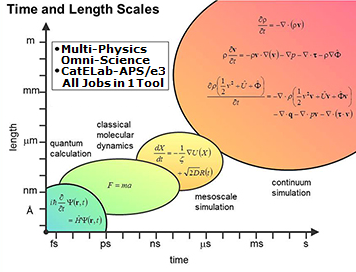
Time- & length scale view of scibase math areas or levels coverage by CatELab-APS/e3 simulator (image by courtesy of Max Planck Institute of Colloids and Interfaces). Relate to the following graphics below. |
|
|
Catalyst Elaboration through virtual Multi-Physics, Omni-Science simulation based on real world mathematical calculation
Our CatELab-APS/e3 catalyst elaboration/E-Lab simulation software is none short of an Omni-Science & a Multi-Physics simulation cross-over hybrid platform, that will be released in various "reactor" kernel and virtual lab versions, as said above emulating any imaginable laboratory setup and configuration found or conceived in the real world. All our product versions for various contemporary science hot spots bear the kinship and the sword's mark of Acwareus Climate-Energy Solutions, be it brought to market under separate trademarks or hosted by separate partnering hosts. Here offered, this Catalyst Elaboration/E-Lab ad hoc setup version through simulations enables the elaboration of GHG-to-fuel CCR transformation and conversion processes by tailoring the catalyst(s) required for meeting the producer's desired fuel type output, in any given inter-combined environmental condition setup with respect to GHG compound and density, temperature, pressure and other key factors. It thereby fully integrates with other featured versions of our product line. The "reactor" kernel, regardless of released version dedicated to a demanded ad-hoc featured scientific hot-spot, operates seamlessly inside all four main fields of mathematical or iteratively approaching numerical fields or levels of calculation: quantum calculation » carries out computations in the small quantum cohomology ring of any Grassmannian of classical type. More precisely, it covers ordinary Grassmannians (type A) and Grassmannians of isotropic subspaces in a symplectic vector space (type C) or in an orthogonal vector space (type B or D), aimed at studying the small quantum cohomology rings of submaximal isotropic and orthogonal Grassmannians. molecular dynamics » studies the physical movements of atoms and molecules, it's thus a type of N-body simulation. Trajectories of atoms and molecules are determined by numerically solving Newton's equations of motion for a system of interacting particles, where forces between the particles and their potential energies are calculated using interatomic potentials or molecular mechanics force fields. mesoscale simulation » visualizes the pattern formation aspects related to materials science. This includes activities on solidification in multicomponent alloys, kinetics of phase transformations, dislocations and cracks, friction, and the modeling of polycrystalline materials, phenomena appearing on dimensions between the atomic and continuum scales. continuum simulation » incorporates calculated smaller-length scale quantities (e g yield stress, chemical reaction pathways) into continuum models. Through the use of arbitrary Lagrange/Eulerian codes, the software evaluates sensitivity and impact of these fundamental quantities at the continuum length scale. All these calculations are accompanied by templates, models, attributes, schemes, configuration, parameterization, and non-mathematical based factual approaches inside e g Biology, Chemistry, Biochemistry, Electro-science %amp; Electronics, Physics etc where e g bacteria, cell-membranes, mitocondria and proteins enter the stage. |
|
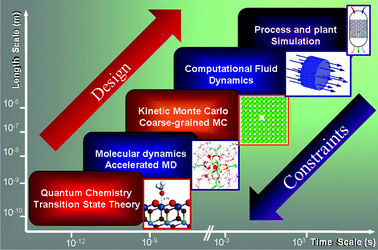
Schematic view of design steps and intrinsic constraints to scibase math areas or levels covered by CatELab-APS/e3 simulator |
|

Bi-projectional (sideways & top-down) views of scibase math areas or levels covered by CatELab-APS/e3 simulator |
|
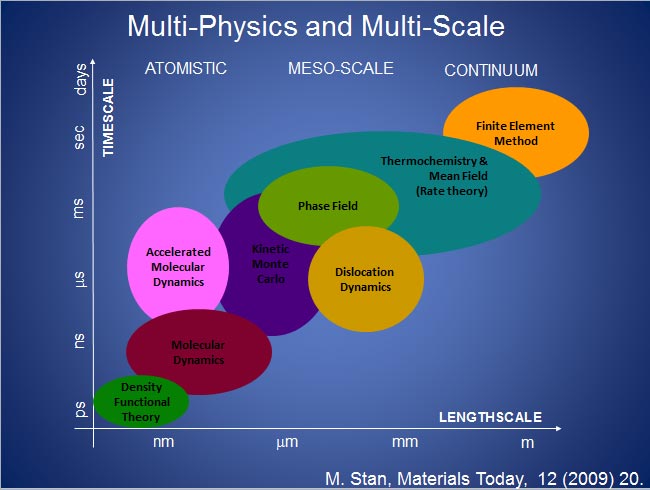
More detailed time- & length scale view of scibase math areas or levels coverage by CatELab-APS/e3 simulator (image by courtesy of M. Stan, Materials Today) |
|
| « Läs mer » | |
| CatELab-APS/e3 forskningsverktyg |

|
 |
|
|
CatELab-APS/e3 = Catalyst ELaborator - Applied Artificial PhotoSynthesis Initiative Software/ (for) energy-ecology-economy (resilient solutions) Goda skäl hela veckan lång att välja vårt forskningsverktyg: • 1 » CatELab-APS/e3 är en uppsättning begreppsmässiga skisser omfattande principerna runt artificiell fotosyntes och deras industriella tillämpningar. • 2 » CatELab-APS/e3 är ett allfunktionellt verktyg för att beskriva varje vetenskaplig verklighet - definiera faktamodeller, korrelationer, templates, inputs och önskade outputs - och för att simulera på alla vetenskapliga samband av fysisk, kemisk, biologisk, elektronisk eller annan natur, även sinsemellan kombinerade. • 3 » Kärnkomponenten är en databas och en gränslös, sömlös sökfunktion som sparar och presenterar sökresultaten som flerdimensionella arrayer och grafiska element. Sökfunktionen filtreras genom en "reaktor" som applicerar modeller, templates etc och som möjliggör simulering på entiteter och APS-processers alla ingående komponenter och produktionsmiljöer. Begripligt för vem som helst - forskare eller annan medarbetare på ditt företag eller forskningsinstitut - extraheras ett inkapslat universum i varje under-sökt och simulerad korrelation. • 4 » Vetenskapliga data är strukturerade som stjärn-scheman i databasen - en fakta-data-kärna med ett obegränsat antal dimensioner av anslut-ande dataattribut - från filimporter, manuell redigering, databaser eller datamängder på nätet och hårda vetenskapliga fakta, data om lanserade produkter, modeller, templates etc. • 5 » Dess föregångare har använts i samman-hang som beskattning & revision, business intel-ligence & datalager, biomedicin & andra bioveten-skaper, vilket visar dess mångsidighet och flexi-bilitet. • 6 » Detta verktyg utgör den oumbärliga följe-slagaren till varje institutionell och experimentell laboratorieverksamhet, genom att eliminera eller skära ner behovet av kostsam utrustning, lokaler, personal, material och substanser till ett absolut minimum. • 7 » Det är också väsentligt för design och konstruktion av olika energi- eller bränsleprodu-cerande verksamheter, och för att bryta ner aktiviteter i allt mer detaljerade, fullt urskiljbara och ändå holistiskt fullt överblickbara hierarkier. Därigenom förvandlas en annars ofta knepig projektplanering, genomförande och uppföljning till en ren njutning - icke att förglömma alla goda skäl som förknippas med att generera, administ-rera och förfoga över välstrukturerad dokumenta-tion på alla nivåer. |
|
| « Läs mer » | |

|
|
|
Kontakta Oss för en CatELab-APS/e3 test! |
|
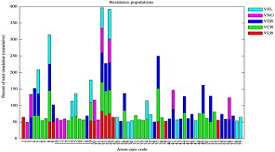
|
|

|
|
| FleXray Anylyzer utility software |

|
|
FleXray Anylyzer is a disruptive epIQ utility software for analyzing anything, any way. This omnifarious & omnipotent utlility is integrated into the Important Facts & Docs section. Its functionality can be applied to any data coming in any type from any source. Check it out to experience its ground-breaking, limitless possibilities! (the analyze functionality portion of this utility is available to FleXray subscribers and to CatELab licensees. Contact us for a demo and for additional information.) |
|
| « Läs mer » | |
| om Oss alla |

|
|
» Om Oss människor » Vårt samhälle utgörs av summan av oss enskilda individer och de beslut vi allesammans fattat och fattar. Samhället blir alltså varken bättre eller sämre än summan av varje människas bidrag, om vi eliminerar yttre makters (p)åverkan. » Vi människor har en fallenhet för att bagatellisera problem, romantisera bilder och senarelägga beslut. Ju större problem, desto farligare kan resultatet av detta bli. Oftast ska en olycka först inträffa innan något görs. Ju viktigare beslut, desto värre konsekvens av att tiden hinner ikapp och kör om. » Det är således viktigt att objektivt och nyktert värdera den föreliggande resp förestående klimatsituationen och ta rätt beslut. » Om vi inväntar utfallet av de scenarion miljöforskare identifierat och presenterat så blir eftertankens kranka blekhet inte en vacker syn - en blekhet lika vit som dödens... » För eftertanke kommer inte att vara till någon nytta - när nyttan av den erfarenheten aldrig kommer i spel därför att matchen är slut, säsongen är slut, serien har lagts ner. Vem kan gilla läget när ingen kan gilla läget? » Vi kan det, allesammans, genom att tänka eftertanken redan idag och komma fram till rätt beslut. » En metaforisk jämförelse: entydig forskning om människans anatomiska utveckling visar att våra händer (särskilt tummens längd) har förändrats grundligt under två miljoner år som ett resultat av vår redskapsanvändning - inte som en anpassning till miljön. » På samma sätt: vill vi förändra våra levnadsvillkor ska vi göra något för dem, inte bara försöka anpassa oss. Håller vi inte alla med om att vi borde försöka förhindra en katastrof? Att slippa behöva fly som råttor - utan någonstans att ta vägen? var god uppge ditt medlemsnr & namn/alias i alla meddelanden till oss |
|
| om Dig |

|
|
» Om Dig » Sluta tvivla, sluta betvivla - tro på möjlig-heterna, engagera dig och samarbeta för framtiden idag. » Du sätter hjulen i rullning, inte "någon annan"... » Du har nog med intelligens, nyfikenhet, mognad, självrespekt, heder & civilkurage till - och Ditt hjärta i - att fatta läget, värdera situationen, ta ställning, sätta ner foten, vara medmänniska, manifestera, påverka... » Hjälp oss hjälpa oss alla genom att engagera dig. Hjälp oss förneka förnekarnas desinformation. Hjälp oss bygga värderingar & ta beslut grundade på kunskap. » Taggar: manifestation, petition, signal, markering, åsikt, ståndpunkt, profilering, lobbying, peppning, attityd, inställning, -->icke-uppgivenhet, icke-förtvivlan, icke-passivitet, proaktivitet, insikt, förtröstan... var god uppge ditt medlemsnr & namn/alias i alla meddelanden till oss |
|
| om Acwareus |

|
|
» Om oss på Acwareus.com »Vi är ett gäng optimistiska realister & orubbliga Earth Club supportrar. » Vi är på faktamässiga grunder övertygade om att begreppet information som styrmedel är nödvändigt och vida överlägset de samhälleliga: ekonomi och politik som styrmedel (såsom skatter & ETS - utsläppsrätter, resp valkampanjer & partikongresser - samt i vissa fall korruption). Därför att information när ett samförstånd mellan konsument och producent - en marknad byggd på kognition. » Vi hoppas att våra föresatser inte ska fördunklas utav eventuella förutfattade förväntningar - du ska hjälpa till att uppfylla dem själv. »Vårt patos: Vi strävar efter att göra Acwareus.com till den självklara portalen, informationskällan och mötesplatsen för alla frågor rörande långsiktiga energi-ekologi-ekonomi (e3) lösningar. » Ingen annanstans finner du målmedvetet sammanställt denna mängd relevant, högkvalitativ information förankrad i en sådan bakomliggande kompetens. » All vår dokumentation, alla nyhetsbrev, grafer, tabeller och fakta oavsett form är källrefererade och copyright-fria ("open source"), inga wikileaks inblandade här. Vi måste ha gått igenom pyramider med källmaterial, och vi kommer att gå igenom åtskilliga fler. »Vi arbetar på en så ideell basis vi bara kan Därför återbetalar vi till equity-ägarna ALLA årliga intäkter från annonsering och sponsring minus skatter och självkostnader* » (Ev villkorade) donationer fonderas i vår stiftelse för egna och andras insatser på området. » Equities återlöses på rullande basis (se "Equity modell" i menyn). Nettobehållningen går oavkortat till PR, marknadsföring, mutfri marknadslobbying, och till vår stiftelse. *Ersättningar för egenutveckling av programvara & databank, forskningsomkostnader, medlemssupport och ev resande, alla i tjänsten » Vår bakgrund: » Vårt team leds av en svensk senior IT-webbutvecklare, databasexpert, technical writer & teknik-freak - mångårig entrepreneur, utbildad i Environment and Sustainable Energy Systems samt Miljökonsekvensanalys på LTH – Lunds Tekniska Högskola, del av Lunds Universitet. Teamet bemannas också av och samarbetar med expertkompetens inom kemi, biologi, multi-fysik, energi, ekologi & miljövetenskaper, ekonomi och marknadsföring. »Se vår vädjan till US Democrats under president(åter)valskampanjen 2012. Det Bästa av Allt till Dig från Oss som kallar den här planeten vårt Hem. var god uppge ditt medlemsnr & namn/alias i alla meddelanden till oss |
|
| om ...Den här (websidan) |

|
|
» Om ...Den här (websidan) » This website intends to break off the ever growing branch of mischief harming the community of website creative and serious designers. Founding a website on e.g Github templates or editing a rudimentary layout in Wordpress, locking the end user up in an endless maze of reloaded, wall-to-wall screen-covering forms, then putting your name on this mess and invoicing the customer a factor ten- or twenty-fold the development cost, implies a both (extremely) boring, predictable, uniform and malfunctional result which in fact even the least apt among the customer's own staff could have achieved. » Our website's visual, functional and technical design wishes to break off this blatantly irresponsible and often fraudulent sign-of-the-times as all to often presented by the IT development community of today. In many respects, it WAS better in the past. In other respects, the customer perceived value needed to improve and break new terrain. Our website represents radically improved customer value, end-user conceived feasibility, extended functionality, and supremely visually and conceptually lucid design. Delve into the details here: » » . . . » . . . please state your member no. & name/alias in all communication with us |
|